Samsung Electronics Co SCHR970C Multi-Band CDMA/ LTE Phone WLAN, Bluetooth and RFID User Manual r970
Samsung Electronics Co Ltd Multi-Band CDMA/ LTE Phone WLAN, Bluetooth and RFID r970
Contents
- 1. Users Manual 1
- 2. Users Manual 2
Users Manual 1

GH68_3XXXXA Printed in Korea
SCH-R970C
ANDROID SMARTPHONE
User Manual
Please read this manual before operating your
phone and keep it for future reference.
This document is watermarked because certain important information in the document has not yet been verified. This document has been sent to you
as a draft and for informational purposes only. The document should only be used for internal purposes and may not be distributed outside of Samsung,
except to Samsung's carrier customer for testing purposes. Distributing the document outside of Samsung, except to Samsung's carrier customer for
testing purposes could result in legal exposure to the company if the preliminary, unverified information in the draft turns out to be inaccurate.
DRAFT
FOR INTERNAL USE ONLY

CRT_SCH-R970C_UM_Eng_MD1_CB_040313_D1
Intellectual Property
All Intellectual Property, as defined below, owned by or which is otherwise the property of Samsung or its respective suppliers
relating to the SAMSUNG Phone, including but not limited to, accessories, parts, or software relating there to (the “Phone
System”), is proprietary to Samsung and protected under federal laws, state laws, and international treaty provisions. Intellectual
Property includes, but is not limited to, inventions (patentable or unpatentable), patents, trade secrets, copyrights, software,
computer programs, and related documentation and other works of authorship. You may not infringe or otherwise violate the
rights secured by the Intellectual Property. Moreover, you agree that you will not (and will not attempt to) modify, prepare
derivative works of, reverse engineer, decompile, disassemble, or otherwise attempt to create source code from the software. No
title to or ownership in the Intellectual Property is transferred to you. All applicable rights of the Intellectual Property shall remain
with SAMSUNG and its suppliers.
Open Source Software
Some software components of this product incorporate source code covered under GNU General Public License (GPL), GNU Lesser
General Public License (LGPL), OpenSSL License, BSD License and other open source licenses. To obtain the source code covered
under the open source licenses, please visit:
http://opensource.samsung.com
.
Disclaimer of Warranties; Exclusion of Liability
EXCEPT AS SET FORTH IN THE EXPRESS WARRANTY CONTAINED ON THE WARRANTY PAGE ENCLOSED WITH THE PRODUCT, THE
PURCHASER TAKES THE PRODUCT "AS IS", AND SAMSUNG MAKES NO EXPRESS OR IMPLIED WARRANTY OF ANY KIND
WHATSOEVER WITH RESPECT TO THE PRODUCT, INCLUDING BUT NOT LIMITED TO THE MERCHANTABILITY OF THE PRODUCT OR
ITS FITNESS FOR ANY PARTICULAR PURPOSE OR USE; THE DESIGN, CONDITION OR QUALITY OF THE PRODUCT; THE
PERFORMANCE OF THE PRODUCT; THE WORKMANSHIP OF THE PRODUCT OR THE COMPONENTS CONTAINED THEREIN; OR
COMPLIANCE OF THE PRODUCT WITH THE REQUIREMENTS OF ANY LAW, RULE, SPECIFICATION OR CONTRACT PERTAINING
DRAFT
FOR INTERNAL USE ONLY

THERETO. NOTHING CONTAINED IN THE INSTRUCTION MANUAL SHALL BE CONSTRUED TO CREATE AN EXPRESS OR IMPLIED
WARRANTY OF ANY KIND WHATSOEVER WITH RESPECT TO THE PRODUCT. IN ADDITION, SAMSUNG SHALL NOT BE LIABLE FOR
ANY DAMAGES OF ANY KIND RESULTING FROM THE PURCHASE OR USE OF THE PRODUCT OR ARISING FROM THE BREACH OF
THE EXPRESS WARRANTY, INCLUDING INCIDENTAL, SPECIAL OR CONSEQUENTIAL DAMAGES, OR LOSS OF ANTICIPATED PROFITS
OR BENEFITS.
Modification of Software
SAMSUNG IS NOT LIABLE FOR PERFORMANCE ISSUES OR INCOMPATIBILITIES CAUSED BY YOUR EDITING OF REGISTRY SETTINGS,
OR YOUR MODIFICATION OF OPERATING SYSTEM SOFTWARE.
USING CUSTOM OPERATING SYSTEM SOFTWARE MAY CAUSE YOUR DEVICE AND APPLICATIONS TO WORK IMPROPERLY. YOUR
CARRIER MAY NOT PERMIT USERS TO DOWNLOAD CERTAIN SOFTWARE, SUCH AS CUSTOM OS.
SAFE™ (Samsung Approved For Enterprise)
SAFE™: "SAFE™" (Samsung for Enterprise) is a mark for a Samsung device which has been tested against Samsung's own
internal criteria for interoperability with certain third party security-related solutions for MDM and VPN. The testing includes field
testing with local network connection and menu tree testing which tests functionality of the solutions in conjunction with the
Samsung device. During the testing, the device is tested with the security solutions to see if the solutions work with the device as
described by the third party security solution providers. The testing, for example, includes field testing with local network
connection and menu tree testing which tests functionality of the solutions in conjunction with the Samsung device. For more
information about Samsung's SAFE™ program, please refer to
www.samsung.com/us/safe
.
Disclaimer of Warranties: EXCEPT AS OTHERWISE PROVIDED IN THEIR STANDARD END USER LICENSE AND WARRANTY, TO THE
FULL EXTENT PERMITTED BY LAW SAMSUNG ELECTRONICS CO., LTD., SAMSUNG TELECOMMUNICATIONS AMERICA, LLC, AND
THEIR AFFILIATES (COLLECTIVELY REFERRED TO HEREIN AS THE "SAMSUNG ENTITIES") EXPRESSLY DISCLAIM ANY AND ALL
WARRANTIES, EXPRESS OR IMPLIED, INCLUDING ANY WARRANTY OF MERCHANTABILITY, FITNESS FOR A PARTICULAR PURPOSE,
INTEROPERABILITY OR NON-INFRINGEMENT, WITH RESPECT TO INFORMATION TECHNOLOGY SECURITY PROTECTION, SAFE™
DRAFT
FOR INTERNAL USE ONLY

DEVICES AND APPLICATIONS TESTED WITH SAFE™ DEVICES. IN NO EVENT SHALL THE SAMSUNG ENTITIES BE LIABLE FOR ANY
DIRECT, INDIRECT, INCIDENTAL, PUNITIVE, OR CONSEQUENTIAL DAMAGES OF ANY KIND WHATSOEVER WITH RESPECT TO
INFORMATION TECHNOLOGY SECURITY PROTECTION, SAFE™ DEVICES OR APPLICATIONS TESTED WITH SAFE™ DEVICES. In
addition, information technology security protection will be affected by features or functionality associated with, among other
things the e-mail platform, master data management, and virtual private network solutions selected by the software provider,
solution provider or user. Choice of an e-mail, master data management, and virtual private network solution is at the sole
discretion of the software provider, solution provider or user and any associated effect on information technology security
protection is solely the responsibility of the software provider, solution provider or user. For complete statement of limited
warranty, please refer to
www.samsung.com/us/safe
, available on the web and where Samsung smartphone and Galaxy Tab™
devices are sold. [101212]
Samsung Telecommunications America (STA), LLC
Headquarters:
1301 E. Lookout Drive
Richardson, TX 75082
Customer Care Center:
1000 Klein Rd.
Plano, TX 75074
Toll Free Tel: 1.888.987.HELP (4357)
DRAFT
FOR INTERNAL USE ONLY

©2013 Samsung Telecommunications America, LLC. Samsung is a registered trademark of Samsung Electronics Co., Ltd.
Do you have questions about your Samsung Mobile Phone?
For 24 hour information and assistance, we offer a new FAQ/ARS System (Automated Response System) at:
www.samsung.com/us/support
Nuance®, VSuite™, T9® Text Input, and the Nuance logo are trademarks or registered trademarks of Nuance Communications,
Inc., or its affiliates in the United States and/or other countries.
ACCESS® and NetFront™ are trademarks or registered trademarks of ACCESS Co., Ltd. in Japan and other countries.
The Bluetooth® word mark, figure mark (stylized “B Design”), and combination mark (Bluetooth word mark and “B Design”) are
registered trademarks and are wholly owned by the Bluetooth SIG.
microSD™ and the microSD logo are Trademarks of the SD Card Association.
Openwave® is a registered Trademark of Openwave, Inc.
Google, the Google logo, Android, the Android logo, Google Play, Gmail, Google Mail, Google Maps, Google Music, Google Talk,
Picasa, YouTube and other marks are trademarks of Google Inc.
Wi-Fi is a registered trademark of the Wireless Fidelity Alliance, Inc.
Swype and the Swype logos are trademarks of Swype, Inc. © 2010 Swype, Inc. All rights reserved.
, DivX®, DivX Certified® and associated logos are trademarks of Rovi Corporation or its subsidiaries and are used under
license.
DivX Certified® to play DivX® video up to HD 720p, including premium content.
Internet Address:
http://www.samsung.com
DRAFT
FOR INTERNAL USE ONLY

ABOUT DIVX VIDEO: DivX® is a digital video format created by DivX, LLC, a subsidiary of Rovi Corporation. This is an official DivX
Certified® device that has passed rigorous testing to verify that it plays DivX video. Visit
www.divx.com
for more information and
software tools to convert your files into DivX videos.
ABOUT DIVX VIDEO-ON-DEMAND: This DivX Certified® device must be registered in order to play purchased DivX
Video-on-Demand (VOD) movies. To obtain your registration code, locate the DivX VOD section in your device setup menu (tap
Applications > Settings > About phone > Legal information > License settings > DivX® VOD > Register
). Go to
vod.divx.com
for more
information on how to complete your registration.
DRAFT
FOR INTERNAL USE ONLY

1
Table of Contents
Section 1: Getting Started .......................... 4
Understanding this User Manual . . . . . . . . . . . . 4
Setting Up Your Phone . . . . . . . . . . . . . . . . . . . 6
Turning Your Phone On . . . . . . . . . . . . . . . . . 13
TTY Mode . . . . . . . . . . . . . . . . . . . . . . . . . . . 15
Voicemail . . . . . . . . . . . . . . . . . . . . . . . . . . . . 15
Displaying Your Phone Number . . . . . . . . . . . 15
Your Google™ Account . . . . . . . . . . . . . . . . . 16
Creating a Samsung Account . . . . . . . . . . . . . 17
Roaming . . . . . . . . . . . . . . . . . . . . . . . . . . . . 17
Securing Your Phone . . . . . . . . . . . . . . . . . . . 18
Section 2: Understanding Your Phone ..... 19
Features . . . . . . . . . . . . . . . . . . . . . . . . . . . . 19
Front View . . . . . . . . . . . . . . . . . . . . . . . . . . . 20
Side Views . . . . . . . . . . . . . . . . . . . . . . . . . . . 21
Back View . . . . . . . . . . . . . . . . . . . . . . . . . . . 22
Navigation . . . . . . . . . . . . . . . . . . . . . . . . . . . 23
Motions . . . . . . . . . . . . . . . . . . . . . . . . . . . . . 24
Notifications . . . . . . . . . . . . . . . . . . . . . . . . . . 33
Home Screen . . . . . . . . . . . . . . . . . . . . . . . . . 35
Customizing the Home Screen . . . . . . . . . . . . 38
Shortcuts . . . . . . . . . . . . . . . . . . . . . . . . . . . . 40
Wallpaper . . . . . . . . . . . . . . . . . . . . . . . . . . . . 41
Apps . . . . . . . . . . . . . . . . . . . . . . . . . . . . . . . 41
Entering Text . . . . . . . . . . . . . . . . . . . . . . . . . 43
Section 3: Accounts and Contacts ...........49
Accounts . . . . . . . . . . . . . . . . . . . . . . . . . . . . 49
Contacts . . . . . . . . . . . . . . . . . . . . . . . . . . . . . 52
Section 4: Calling ......................................62
Making Calls . . . . . . . . . . . . . . . . . . . . . . . . . 62
Multi-party Calling . . . . . . . . . . . . . . . . . . . . . 64
Answering Calls . . . . . . . . . . . . . . . . . . . . . . . 65
Ending a Call . . . . . . . . . . . . . . . . . . . . . . . . . 66
Recent Calls . . . . . . . . . . . . . . . . . . . . . . . . . . 66
Call Settings . . . . . . . . . . . . . . . . . . . . . . . . . . 68
DRAFT
FOR INTERNAL USE ONLY
2
Section 5: Messaging ................................73
Types of Messages . . . . . . . . . . . . . . . . . . . . .73
Text and Multimedia Messaging . . . . . . . . . . .73
Emergency alerts . . . . . . . . . . . . . . . . . . . . . .77
Email . . . . . . . . . . . . . . . . . . . . . . . . . . . . . . . . 78
Gmail . . . . . . . . . . . . . . . . . . . . . . . . . . . . . . .79
Google Talk . . . . . . . . . . . . . . . . . . . . . . . . . . .80
Messenger . . . . . . . . . . . . . . . . . . . . . . . . . . . 81
Section 6: Applications and Widgets .......82
Accessing Applications . . . . . . . . . . . . . . . . . .82
Applications List . . . . . . . . . . . . . . . . . . . . . . .84
Accessing Widgets . . . . . . . . . . . . . . . . . . . .123
Section 7: Connections ...........................126
Wi-Fi . . . . . . . . . . . . . . . . . . . . . . . . . . . . . . .126
Wi-Fi Direct . . . . . . . . . . . . . . . . . . . . . . . . . .127
Bluetooth . . . . . . . . . . . . . . . . . . . . . . . . . . .128
VPN . . . . . . . . . . . . . . . . . . . . . . . . . . . . . . . .129
PC Connections . . . . . . . . . . . . . . . . . . . . . . . 130
Tethering . . . . . . . . . . . . . . . . . . . . . . . . . . .132
Portable Wi-Fi Hotspot . . . . . . . . . . . . . . . . . .132
Beaming . . . . . . . . . . . . . . . . . . . . . . . . . . . .134
Nearby devices . . . . . . . . . . . . . . . . . . . . . . .135
Screen Mirroring . . . . . . . . . . . . . . . . . . . . . .136
Memory Card . . . . . . . . . . . . . . . . . . . . . . . . .136
Section 8: Settings ..................................137
Accessing Settings . . . . . . . . . . . . . . . . . . . .137
Connections . . . . . . . . . . . . . . . . . . . . . . . . .139
My device . . . . . . . . . . . . . . . . . . . . . . . . . . .152
Accounts . . . . . . . . . . . . . . . . . . . . . . . . . . . .175
More . . . . . . . . . . . . . . . . . . . . . . . . . . . . . . .185
Section 9: Health and Safety
Information ........................................193
Exposure to Radio Frequency (RF) Signals . . .193
Specific Absorption Rate (SAR) Certification
Information . . . . . . . . . . . . . . . . . . . . . . . . .198
FCC Part 15 Information to User . . . . . . . . . . .200
Commercial Mobile Alerting System (CMAS) .200
Smart Practices While Driving . . . . . . . . . . . .200
Battery Use and Safety . . . . . . . . . . . . . . . . .202
Samsung Mobile Products and Recycling . . . .204
UL Certified Travel Charger . . . . . . . . . . . . . .205
Display / Touch-Screen . . . . . . . . . . . . . . . . .205
GPS . . . . . . . . . . . . . . . . . . . . . . . . . . . . . . . .206
Emergency Calls . . . . . . . . . . . . . . . . . . . . . .206
DRAFT
FOR INTERNAL USE ONLY
3
Care and Maintenance . . . . . . . . . . . . . . . . . 207
Responsible Listening . . . . . . . . . . . . . . . . . 208
Operating Environment . . . . . . . . . . . . . . . . 210
FCC Hearing Aid Compatibility (HAC)
Regulations for Wireless Devices . . . . . . . 212
Restricting Children's Access to
Your Mobile Device . . . . . . . . . . . . . . . . . . 214
FCC Notice and Cautions . . . . . . . . . . . . . . . 214
Other Important Safety Information . . . . . . . 215
Section 10: Warranty Information ..........217
Standard Limited Warranty . . . . . . . . . . . . . . 217
End User License Agreement for Software . . 222
Index .........................................................230
DRAFT
FOR INTERNAL USE ONLY

4
Section 1: Getting Started
This section allows you to quickly start using your Samsung
SCH-R970C phone by installing the SIM and (optional)
microSD cards, installing and charging the battery, activating
your service, and setting up your voicemail account.
Understanding this User Manual
The sections of this manual generally follow the features of
your phone. A robust index for features begins on page 230.
Also included is important safety information that you should
know before using your phone. Most of this information is
near the back of the guide, beginning on page 193.
This manual gives navigation instructions according to the
default display settings. If you select other settings,
navigation steps may be different.
Unless otherwise specified, all instructions in this manual
assume that you are starting from the Home screen. To get to
the Home screen, you may need to unlock the phone or
keypad. (For more information, refer to “Securing Your
Phone” on page 18.)
Note:
Instructions in this manual are based on default settings,
and may vary from your phone, depending on the
software version on your phone, and any changes to the
phone’s Settings.
Unless stated otherwise, instructions in this User
Manual start with the phone unlocked, at the Home
screen.
All screen images in this manual are simulated. Actual
displays may vary, depending on the software version of
your phone and any changes to the phone’s Settings.
DRAFT
FOR INTERNAL USE ONLY

Getting Started 5
Special Text
In this manual, you’ll find text that is set apart from the rest.
These are intended to point out important information, share
quick methods for activating features, to define terms, and
more. The definitions for these methods are as follows:
•
Notes
: Presents alternative options for the current feature, menu,
or sub-menu.
•
Tips
: Provides quick or innovative methods, or useful shortcuts.
•
Example
: Gives an example of the feature or procedure.
•
Important
: Points out important information about the current
feature that could affect performance.
•
Warning
: Brings to your attention important information to
prevent loss of data or functionality, or even prevent damage to
your phone.
Text Conventions
This manual provides condensed information about how to
use your phone. To make this possible, the following text
conventions are used to represent often-used steps:
Example:
“Press
Home
, then touch
Menu
➔
Settings
➔
Connections
➔
Wi-Fi
.”
➔
Arrows are used to represent the sequence of
selecting successive options in longer, or
repetitive, procedures.
DRAFT
FOR INTERNAL USE ONLY
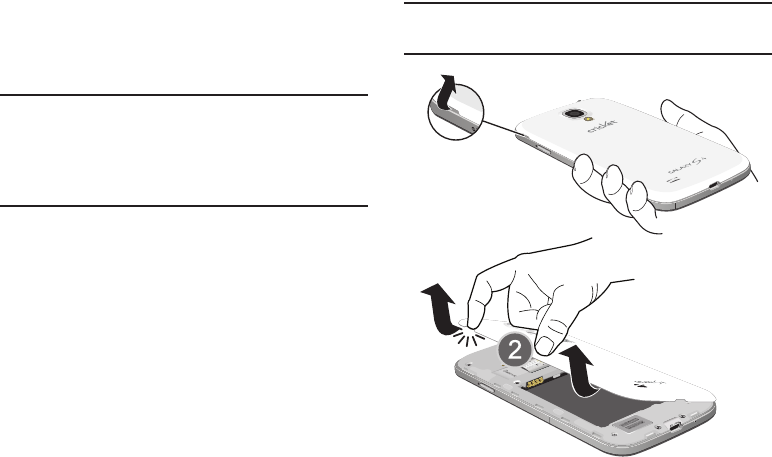
6
Setting Up Your Phone
Before using your phone, you need to install the SIM card,
the microSD™ card, and the battery into their respective
internal slots and compartment.
Important!
Before removing or replacing the battery cover,
make sure the phone is switched off. To turn the
phone off, hold down the power key until the
power-off image displays, then touch
Power off
.
Removing the battery cover
1. Locate the cover removal opening (1).
2. Place your fingernail in the opening and pry the cover
away from the device (2).
Caution!
Do not bend or twist the back cover excessively.
Doing so may damage the cover.
DRAFT
FOR INTERNAL USE ONLY
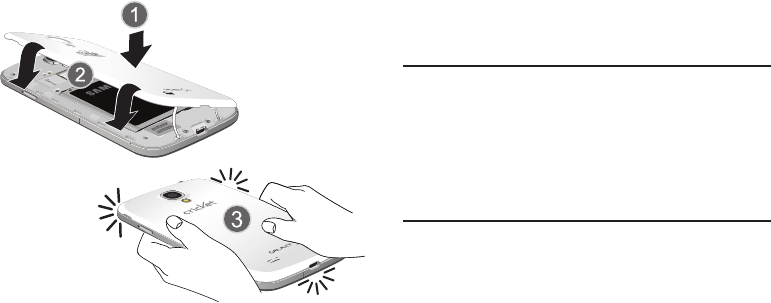
Getting Started 7
Installing the battery cover
Align the cover (1) and press it firmly into place (2),
making sure it snaps into place at the corners.
Installing the SIM Card
When you subscribe to a 4G LTE cellular network, you are
provided with a plug-in SIM card loaded with your
subscription details, such as your PIN, available optional
services, and many others features. This SIM card will only
work with this device.
Important!
The SIM card must be installed for your phone to
establish a network connection.
The plug-in SIM card information and its contacts
can be easily damaged by scratching or bending,
so be careful when handling, inserting, or
removing the card. Keep all SIM cards out of reach
of small children.
1. Remove the battery cover. (See “Removing the battery
cover” on page 6.)
2. Locate the SIM card slot on the top inside of the phone.
3. Make sure the gold contacts of the SIM card face
downward and that the notched corner of the card
faces outward to the right (as shown).
4. Carefully slide the SIM card into the SIM card socket
(as shown) until the card locks into place.
DRAFT
FOR INTERNAL USE ONLY
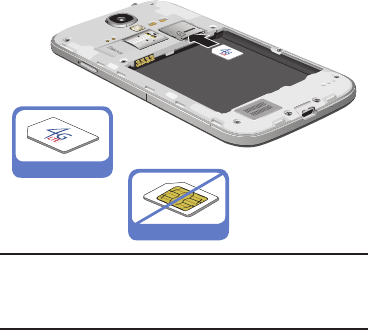
8
Note:
If the SIM card is not inserted correctly, the phone
cannot make a network connection.
Once the SIM card is inserted, do not remove it.
Removing the SIM Card
1. Remove the battery cover.
2. Remove the battery.
3. Firmly press the card into the slot and release it. The
card should pop partially out of the slot.
4. Remove the card from the slot.
5. Replace the battery cover.
Installing a Memory Card
Your device lets you install an (optional) microSD (SD) or
microSDHC memory card to expand available memory to
store images, videos, music, applications, and data.
1. Remove the battery cover. (See “Removing the battery
cover” on page 6.)
2. Locate the microSD card slot on the top inside of the
phone.
3. With the gold contacts facing down, carefully slide the
memory card into the slot (as shown), pushing gently
until it clicks into place.
Correct
Incorrect
DRAFT
FOR INTERNAL USE ONLY
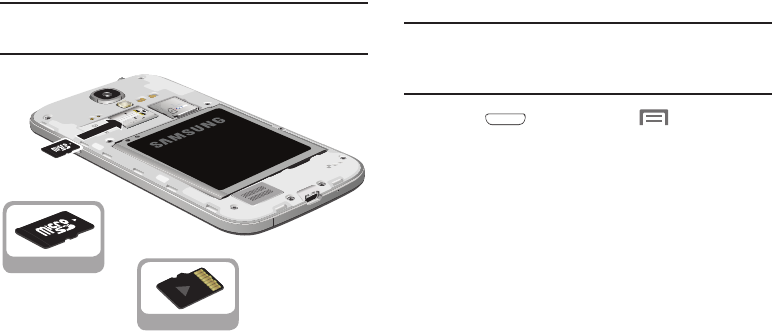
Getting Started 9
Important!
Be sure to align the gold contact pins on the
memory card with the phone’s contacts.
Removing a Memory Card
Important!
To prevent damage to information stored on the
memory card, unmount the card before removing it
from the phone.
1. Press
Home
, then touch
Menu
➔
Settings
➔
More
➔
Storage
➔
Unmount SD card
. (For
more information, refer to “Storage” on page 190.)
2. Remove the battery cover. (See “Removing the battery
cover” on page 6.)
3. Firmly press the Memory card into the slot and
carefully release it. The card should pop partially out of
the slot.
4. Remove the card from the slot.
5. Replace the battery cover. For more information, refer
to “Installing the battery cover” on page 7.
Correct
Incorrect
DRAFT
FOR INTERNAL USE ONLY
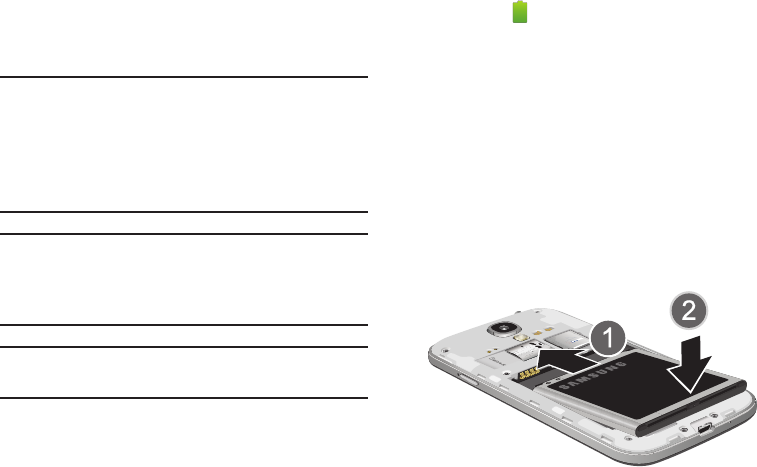
10
Battery
Your phone is powered by a rechargeable, standard Li-Ion
battery. A Wall/USB Charger (Charging Head and USB cable)
is included with the phone, for charging the battery.
Note:
The battery comes partially charged. You must fully
charge the battery before using your phone for the first
time. A fully discharged battery requires up to 4 hours of
charge time.
After the first charge, you can use the phone while
charging.
Warning!
Use only Samsung-approved charging devices and
batteries. Samsung accessories are designed to
maximize battery life. Using other accessories may
invalidate your warranty and may cause damage.
Note:
Failure to unplug the wall charger before you remove the
battery, can cause damage to the phone.
Battery Indicator
The battery icon in the Annunciator Line shows battery
power level. Two to three minutes before the battery
becomes too low to operate your phone, the empty battery
icon will flash and a tone will sound. If you continue to
operate the phone without charging the battery, the phone
will power off.
Installing the Battery
1. Remove the battery cover. (See “Removing the battery
cover” on page 6.)
2. Slide the battery into the compartment (1) so that the
tabs on the end align with the slots at the bottom of the
phone, making sure the connectors align.
3. Gently press down to secure the battery (2).
DRAFT
FOR INTERNAL USE ONLY
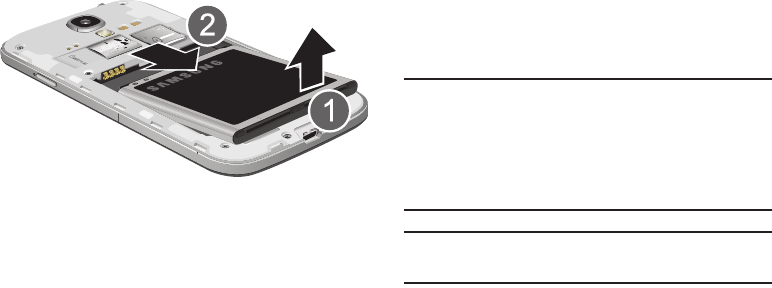
Getting Started 11
Removing the Battery
1. Remove the battery cover. (See “Removing the battery
cover” on page 6.)
2. Lift the battery up by the slot provided (1).
3. Lift the battery up and out of the phone (2).
Charging the Battery
Your phone is powered by a rechargeable Li-ion battery. A
wall charger, which is used for charging the battery, is
included with your phone. Use only approved batteries and
chargers. Ask your local Samsung dealer for further details.
Before using your phone for the first time, you must fully
charge the battery. A discharged battery recharges fully in
approximately 4 hours.
Note:
Verify that the battery is installed prior to connecting the
wall charger. If both the wall charger is connected and
the battery is not installed, the handset will power cycle
continuously and prevent proper operation. Failure to
unplug the wall charger before you remove the battery,
can cause the phone to become damaged.
Important!
It is recommended you fully charge the battery
before using your device for the first time.
DRAFT
FOR INTERNAL USE ONLY
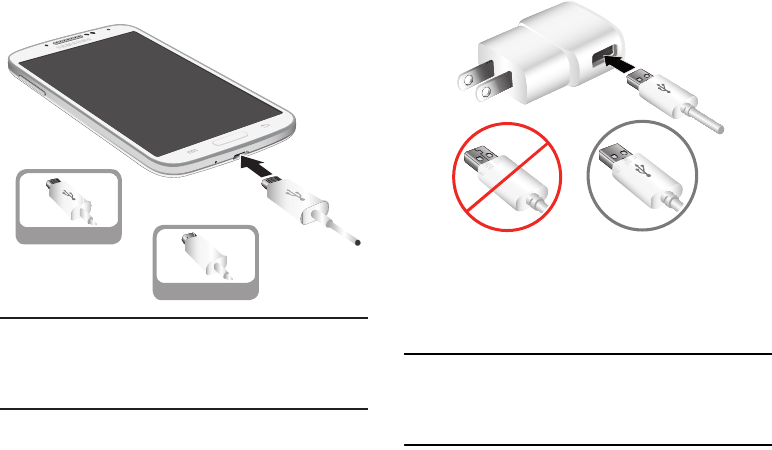
12
1. Insert the USB cable into the device’s Charger/
Accessory jack at the bottom of the device.
Note:
This illustration displays both the
correct
and
incorrect
orientation for connecting the USB cable. If the USB
cable is incorrectly connected, damage to the accessory
port will occur therefore voiding the phone’s warranty.
2. Connect the USB cable to the charging head.
3. Plug the charging head into a standard AC power
outlet. The device turns on with the screen locked and
indicates both its charge state and percent of charge.
Warning!
While the device is charging, if the touch screen
does not function due to an unstable power supply
unplug the USB power adapter from the power outlet
or unplug the USB cable from the device.
Correct
Incorrect
Correct
Incorrect
DRAFT
FOR INTERNAL USE ONLY
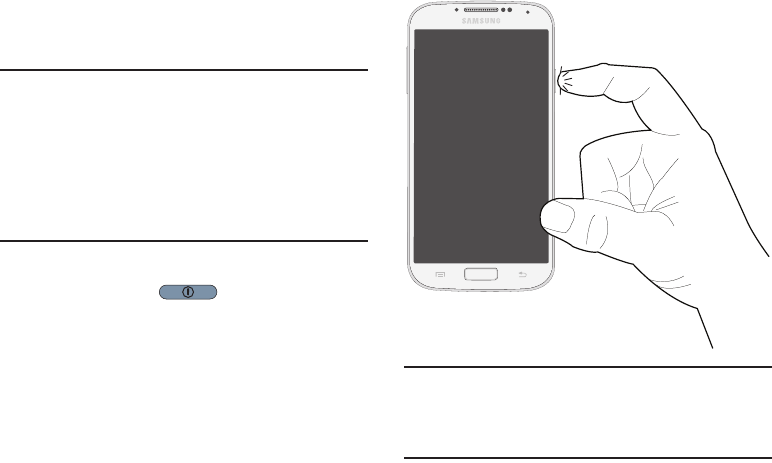
Getting Started 13
4. When charging is finished, first unplug the charger’s
power plug from the AC wall outlet, then disconnect
the USB cable connector from the device.
Important!
If your handset has a touch screen display, please
note that a touch screen responds best to a light
touch from the pad of your finger or a non-metallic
stylus. Using excessive force or a metallic object
when pressing on the touch screen may damage
the tempered glass surface and void the warranty.
For more information, refer to “Standard Limited
Warranty” on page 217.
Turning Your Phone On
Press and hold the
Power/Lock
key (on the
upper right side of the phone) for three seconds.
While powering on, the phone connects with the
network, then displays the Locked screen and any
active Notification alerts.
Note:
Your phone’s internal antenna is located along the
bottom back of the phone. Do not block the antenna;
doing so may affect call quality or cause the phone to
operate at a higher power level than necessary.
DRAFT
FOR INTERNAL USE ONLY

14
Unlocking Your Phone
1. If needed, press Press
Home
to wake
the screen.
2. If there are no
Notification alerts on
your phone, swipe the
screen to unlock it.
The Home screen
appears.
Note:
If you have purchased your phone online, the first time
you power your phone on and unlock the screen, the
Activation Wizard
Welcome
screen appears.
Follow the prompts to activate and set-up your phone.
Turning Your Phone Off
1. Press and hold the
Power/Lock
Key
(on the
upper right side of the device) for two seconds.
2. At the prompt, touch
Power off
. The
Power off
pop-up
appears.
3. At the prompt, touch
OK
.
DRAFT
FOR INTERNAL USE ONLY

Getting Started 15
TTY Mode
Your phone is fully TTY-compatible, allowing you to connect a
TTY device to the phone’s headset jack. Before you can use
your phone with a TTY device, you’ll need to enable TTY
Mode.
For more information, refer to “Other call settings” on page
72.
Voicemail
All unanswered calls to your phone are sent to voicemail,
even if your phone is turned off, so you’ll want to set up your
voicemail and personal greeting as soon as you activate your
phone.
Setting up Voicemail
1. Press
Home
, then touch
Phone
, then
touch and hold .
2. Follow the automated instructions to set up your new
password and record a greeting.
Checking Voicemail
1. Press
Home
, then touch
Phone
, then
touch and hold .
2. Follow the automated instructions to manage
voicemail.
Tip:
You can also access
Voicemail
by dialing your phone
number from any touch-tone phone.
Displaying Your Phone Number
Press
Home
, then touch
Menu
➔
Settings
➔
About device
➔
Status
.
Your phone number displays under
My phone number
.
DRAFT
FOR INTERNAL USE ONLY

16
Your Google™ Account
Your new phone uses your Google account to fully utilize its
Android features, including Gmail, Google Maps, Google Talk,
and the Google™ Play apps. When you turn on your phone
for the first time, you should set up a connection with your
existing Google account, or create a new Google account.
1. Press
Home
, then touch
Applications
➔
Gmail
.
The
Add a Google Account
screen displays.
2. Touch
Existing
or
New
to continue.
3. Follow the on-screen instructions to sign in if you
already have a Google account, or to create a Google
Account.
Resetting your Google Account Password
A Google account password is required for Google
applications. If you misplace or forget your Google Account
password, follow these instructions to reset it:
1. From your computer, use an Internet browser to
navigate to
http://google.com/accounts
.
2. Once the Web Page loads, click on the
Can’t access
your account?
link.
3. Under
Forgot your password?
, follow the password
reset prompts.
DRAFT
FOR INTERNAL USE ONLY

Getting Started 17
Creating a Samsung Account
An active Samsung account is required to use applications
such as AllShare Play and Media Hub.
1. From the Home screen, touch
Menu
➔
Settings
.
The
Settings
screen appears in the display.
2. Under Accounts, touch
Add account
.
3. From the
Add account
screen, touch
Samsung
account
.
4. From the
Samsung account
screen, touch
Create new
account
and follow the on-screen instructions to create
a Samsung account.
5. Read the Terms and conditions, then touch the
I accept
all the terms
above
check box.
6. Touch
Agree
.
7. Enter the required information and touch
Sign up
.
8. At the Welcome screen, touch
Next
.
9. Follow the on-screen instructions to verify your email
address and activate your account.
Roaming
When you travel outside your home network’s coverage area,
your phone can roam to acquire service on other compatible
digital networks. When Roaming is active, the Roaming icon
( ) appears in the Annunciator Line (Notification Bar) of
the display.
Tip:
You can set your phone’s roaming behavior. (For more
information, refer to “Mobile networks” on page 146.)
During roaming, some services may not be available.
Depending on your coverage area and service plan, extra
charges may apply when making or receiving calls.
Note:
Contact your Wireless Provider for more information
about your coverage area and service plan.
DRAFT
FOR INTERNAL USE ONLY

18
Securing Your Phone
By default, the phone locks automatically when the screen
times out, or you can lock it manually. You can unlock the
phone using one of the default Unlock screens, or for
increased security, use a personal screen unlock pattern, a
Personal Identification Number (PIN), or a password.
For more information about creating and enabling a Screen
unlock pattern, see “Lock screen” on page 152.
Note:
Unless stated otherwise, instructions in this User Manual
start with the phone unlocked, at the Home screen.
Locking the phone manually
Press the
Power/Lock
key on the top right
side of the phone.
Unlocking the phone
For information on unlocking your phone, see “Unlocking
Your Phone” on page 14.
Unlocking with a Personal Screen Unlock Pattern
1. Press
Home
to wake the screen.
2. Draw your personal unlock pattern on the screen.
For more information, refer to “Lock screen” on page 152.
Unlocking with a Password
1. Press
Home
to wake the screen.
2. Enter your Password.
3. Press
OK
.
DRAFT
FOR INTERNAL USE ONLY

Understanding Your Phone 19
Section 2: Understanding Your Phone
Features
•
5.0-inch 1920x1080 Super AMOLED Full HD touch screen
•
CDMA 1X/EV-DO Rev-A /LTE Wireless Technology
•
1.9 gigahertz quad-core processor with 16 or 32 GB memory and
2 GB RAM
•
Android
®
4.2 platform
•
Google Play
™
Store, plus pre-loaded applications
•
SAFE
™
Certified
•
Connections
–
Wi-Fi 802.11 a/b/g/n (2.4 and 5 GHz bands)
–
Mobile Hotspot
–
Bluetooth 4.0
–
Tethering
–
VPN
–
NFC
–
Android Beam
–
S Beam
–
Wi-Fi Direct
–
AllShare Cast
–
DLNA
–
USB 2.0
•
Messaging Services
–
Text Messaging
–
Picture Messaging
–
Video Messaging
–
Voice Messaging
–
Email
–
Mobile Instant Messenger (IM)
–
Chat
•
13 Megapixel Camera-Camcorder with LED flash + 2 Megapixel
Front Camera-Camcorder
•
Picture Gallery
•
Video Player (1080p — MP4 and 3GP)
•
DivX Certified
®
to play DivX
®
video up to HD 1080p, including
premium content
•
Music Player (AAC, AAC+, eAAC+, MP3, and WMA)
•
Speakerphone
•
Support for microSD™ and microSDHC™ Memory Cards up to
64GB capacity
DRAFT
FOR INTERNAL USE ONLY
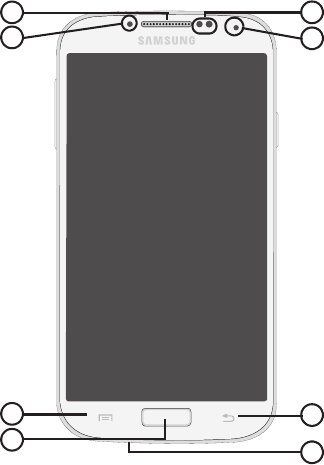
20
Front View
1.
Earpiece
:
Use during calls to listen to callers.
2.
LED Indicator
: Flashes or glows to alert you to alert
notifications or phone status.
3.
Menu Key
: Press to display options for the current
screen.
4.
Home Key
: Press to display the Home screen, or Lock
screen if the phone is locked. Press and hold to display
recent applications or to launch Task Manager.
5.
Microphone
: Use during calls to allow callers to hear
your voice, and when recording.
6.
Back Key
: Press to return to the previous screen or
option.
7.
2 Megapixel Front Camera
: Use for taking pictures and
recording video.
8.
Proximity and Light Sensors
: Detect the presence of
nearby objects to control device functions or blank the
screen display, such as when you hold the phone to
your ear during a phone call. Detect ambient light to
determine screen brightness when
Brightness
is set to
Automatic brightness
(see “Brightness” on page 155),
and when taking pictures with the Front camera.
1
2
3
4
6
5
7
8
DRAFT
FOR INTERNAL USE ONLY
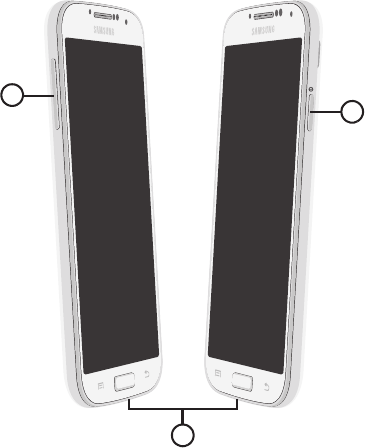
Understanding Your Phone 21
Side Views
1.
Volume Key
: From the Home screen, touch to adjust
Master Volume. During calls or music playback, press
to adjust volume. Press to mute the ringtone of an
incoming call.
2.
USB
Power/Accessory Port
: Connect a USB cable for
charging or to sync music and files.
3.
Power/Lock Key
: Press and hold to turn the phone on or
off. Press to lock the phone, or to wake the screen for
unlocking.
13
2
DRAFT
FOR INTERNAL USE ONLY
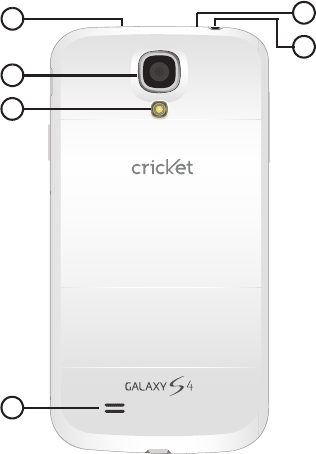
22
Back View
1.
Infrared Lens
: Use when controlling media devices
remotely.
2.
13 Megapixel Camera Lens
: Use when taking photos or
recording videos.
3.
Camera Flash
: Use when taking photos.
4.
External Speaker
: Play ringtones, call audio when in
Speakerphone mode, media sounds (music and video),
and other sounds.
5.
3.5mm Headset Jack
: Plug in an optional headset or
TTY equipment.
6.
Noise cancelation microphone
: Captures background
noise that the phone uses to produce a quiet
background during calls and video chats.
1
2
3
4
6
5
DRAFT
FOR INTERNAL USE ONLY

Understanding Your Phone 23
Navigation
Navigate your phone’s features using the command keys and
the touch screen.
Warning!
Please note that a touch screen responds best to a
light touch from the pad of your finger or a non-
metallic stylus. Using excessive force or a metallic
object when pressing on the touch screen may
damage the tempered glass surface and void the
warranty. For more information, see “Warranty
Information” on page 217.
Context-sensitive Menus
While using your phone, context-sensitive menus offer
options for the feature or screen currently in use.
To access context-sensitive menus:
•
Touch
Menu
.
•
Touch and hold on an item.
Command Keys
Menu Key
Touch
Menu
to display a context-sensitive menu of
options for the current screen or feature.
Home Key
Press the
Home Key
to display the Home screen.
Press and hold the
Home Key
to launch a menu of
recent applications, or to launch Task Manager.
Back Key
Touch
Back
to return to the previous screen, option or
step.
DRAFT
FOR INTERNAL USE ONLY
24
Motions
Finger Motions
Touch
Touch items to select or launch them. For example:
•
Touch the on-screen keyboard to enter characters or text.
•
Touch an item to select it.
•
Touch an app’s icon to launch the application.
Touch and Hold
Activate on-screen items by a touch and hold gesture. For
example:
•
Touch and hold a widget or icon on the Home screen to move it.
•
Touch and hold on a field to display a pop-up menu of options.
Swipe
Swipe your finger vertically or horizontally across the screen.
For example:
•
Unlocking the screen
•
Scrolling the Home screen or a menu
•
Combine touch and hold with swipe to drag an item to a new
location.
Pinch
Using two fingers, make a pinch motion on the screen. For
example:
•
Pinch in to zoom in on pictures or screens.
•
Pinch out to zoom out on pictures or screens.
DRAFT
FOR INTERNAL USE ONLY
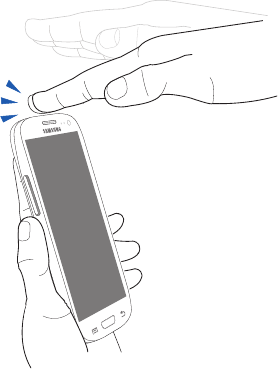
Understanding Your Phone 25
Motions
Your phone recognizes motion, to allow you to navigate and
access features by moving the phone in specific patterns.
To use motions to control your phone, enable the
Motion
settings. (For more information, see “Motions and gestures”
on page 173.)
•
Direct call
: When this option is set to On, you can lift the phone to
your ear to call a contact displayed in a Messaging, Contacts, or
Call Log screen.
•
Smart alert
: When this option is set to On, you can lift the phone
to be automatically notified of missed calls, messages, and alerts
that occurred while the phone was stationary.
•
Double tap to top
: When this option is set to On, a double tap on
the top of the phone takes you to the top of the list.
DRAFT
FOR INTERNAL USE ONLY
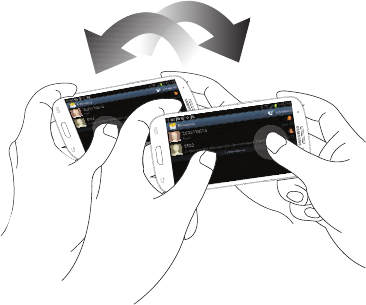
26
•
Tilt to zoom
: When this option is set to On, touching and holding
with your thumbs on the screen while in Gallery or Internet, then
tilting the phone forward and back causes the screen to zoom in
or out.
•
Pan to move icon
: When this option is set to On, touching and
holding on the screen, then moving the phone in a side-to-side
motion, moves a highlighted icon to a new location on the Home
screen.
•
Pan to browse images
: When this option is set to On, moving the
phone in a panning motion while viewing an image moves focus
around in the image.
•
Shake to update
: When this option is set to On, shaking the
phone causes Bluetooth or Wi-Fi screens to scan for devices.
DRAFT
FOR INTERNAL USE ONLY
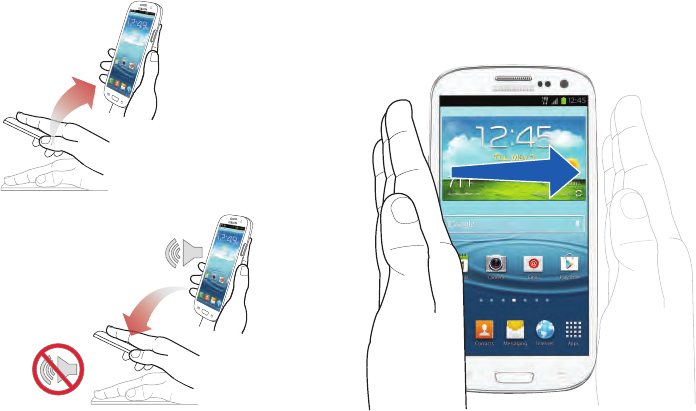
Understanding Your Phone 27
•
Turn over to mute/pause
: When this option is set to On, turning
the phone screen-down automatically mutes incoming call
ringtones and alerts sounds.
Hand motions
Use your hand to swipe across the screen, or cover the
screen.
•
Palm swipe to capture
: When this option is set to On, swiping
the screen with the side of your hand (left to right, or right to left)
captures a screen shot.
DRAFT
FOR INTERNAL USE ONLY
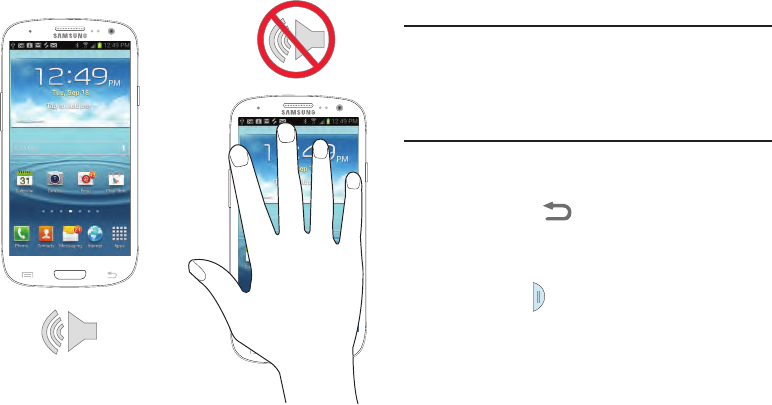
28
•
Palm touch to mute/pause
: When this option is set to On, covering
the screen with your hand mutes or pauses media playback.
Using Multi Window
This feature allows you to run multiple applications on the
current screen at the same time.
Note:
Only applications found within the Multi window tray can
be active atop another current application on the screen.
When launching applications that contain multimedia
files (music/video), audio from both files will be played
simultaneously.
Activating and Deactivating Multi window
To activate Multi window:
1. Touch and hold
Back
. The Multi window tray
appears briefly (by default) on the left side of the
screen, then closes, leaving only the Multi window tab
showing.
2. Touch the tab to open the Multi window tray,
showing some of the available Multi window apps.
3. Swipe the tray upwards to show more Multi window
apps.
DRAFT
FOR INTERNAL USE ONLY
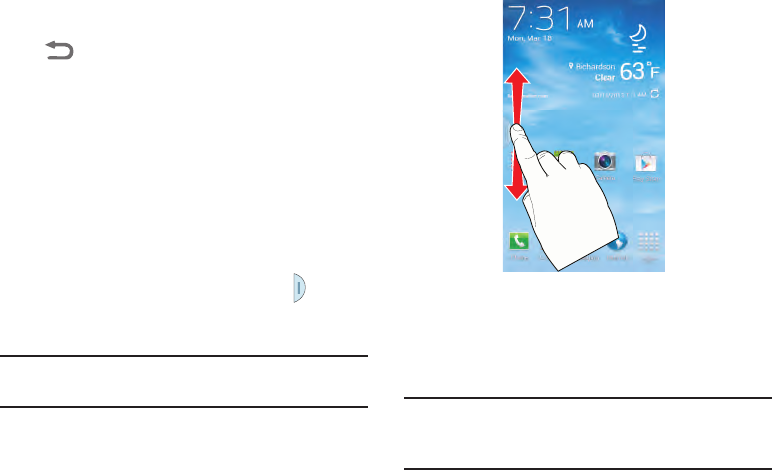
Understanding Your Phone 29
To deactivate Multi window:
With the Multi window tab showing, touch and hold
Back
. This action hides the Multi window tab
from view.
Repositioning the Multi Window
The Multi window contains two components: tab and apps
tray. The tab can be manually moved across the screen. The
apps tray (containing the scrollable apps) can be relocated to
launch from any side of the screen (top, bottom, left, or
right).
To move the tab:
1. Activate the Multi window feature. (See “To activate
Multi window:” on page 28.)
2. In a single motion, touch and hold the tab for
approximately one-second, then slowly drag it to its
new location
along the current
screen edge.
Note:
This is a quick way to get the tab out of the way if you
can’t get to a button or option behind it.
To relocate the Multi window tray:
1. Activate the Multi window feature. (See “To activate
Multi window:” on page 28.)
2. Touch the tab to display the apps tray (containing the
scrollable apps).
Note:
Notice that when the apps are visible, the tab turns a
dark grey. Its only in this state that the entire panel can
be relocated.
DRAFT
FOR INTERNAL USE ONLY
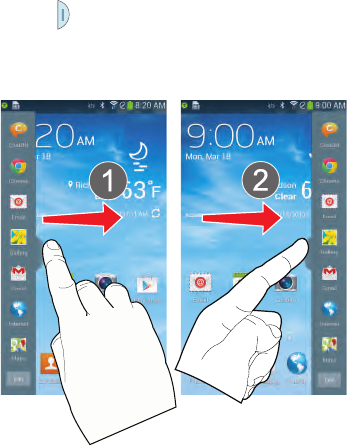
30
3. In a single motion, touch and hold the Multi window
tab for approximately one-second to detach it from
the screen (1), then slowly drag it to its new location
along any other
available screen edge (2). You can
move it to the top, bottom, or either side.
Customizing the Multi Window tray
The applications found within the Multi window tray can be
organized by either being rearranged or removed.
To rearrange the Multi window applications:
1. Activate the Multi window feature.
2. Touch the tab to display the apps tray (containing the
scrollable apps).
3. In a single motion, touch and hold a desired app until it
detaches from the tray, then carefully drag it to a new
location in the list of apps. Lift your finger or stylus off
the screen to let go of the app and drop it into its new
location.
To remove a Multi window application:
1. Activate the Multi window feature.
2. Touch the tab to display the Multi window tray
(containing the scrollable apps).
3. Touch
Edit
(located at the bottom of the list).
4. Follow the prompt to remove apps from the Multi
window tray to the revealed staging area.
5. Tap
Done
once you have completed the removal
process.
DRAFT
FOR INTERNAL USE ONLY

Understanding Your Phone 31
To restore a Multi window application:
1. Activate the Multi window feature.
2. Tap the tab to display the apps panel (containing the
scrollable apps).
3. Tap the
Edit
button (located at the bottom of the list) to
reveal the staging area containing any previously
removed apps.
4. Locate the desired application.
5. In a single motion, touch and hold a desired app until it
detaches from the staging area, then carefully drag it
to a new location in the current list of apps.
Using Multi Window to run multiple apps on the same
screen
Any of the apps found within the Multi window panel can be
run at the same time as a current on-screen app.
Once multiple apps are running on the same screen, you can
then choose to either swap their positions or maximize a
desired app.
Note:
Only applications found within the Multi-window panel
can be active atop another current application on the
screen.
When launching applications that contain multimedia
files (music/video), audio from both files will be played
simultaneously.
In this example we will be launching both the Internet and
Maps applications.
1. Launch an application, such as Internet.
•
From the Home screen, touch
Internet
.
2. Activate the Multi window feature. (See “To activate
Multi window:” on page 28.)
3. Touch the Multi window tab to display the apps tray.
4. Touch and hold the desired app, such as
Maps
,
until it detaches from the tray.
5. In a single motion, drag the app over the current app
and drop the new Multi window app over either the top
or bottom area of the current on-screen app.
DRAFT
FOR INTERNAL USE ONLY
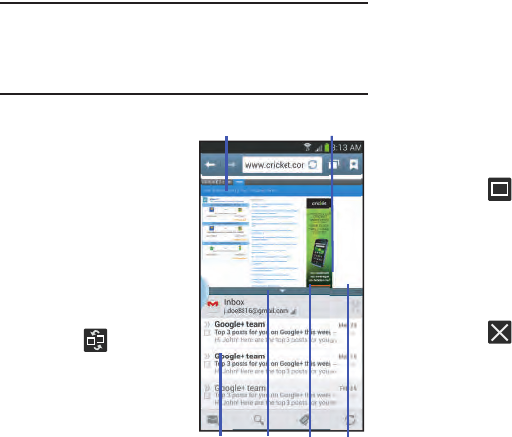
32
Note:
Once two applications are running, the device displays a
split screen view containing both the initial app and the
new Multi window app. Each application is still
independent of the other.
To swap the locations of the
applications:
1. With the two
applications shown in a
split screen, touch the
Border bar to show the
on-screen icons.
2. Touch the desired
application area (top or
bottom).
3. Touch
Swap apps
.
The current apps swap
places.
To increase the size of a desired application window:
With the two applications shown in a split screen,
touch and hold the Border bar, then drag it to resize the
desired window.
To seperate the current applications:
1. With the two applications shown in a split screen,
touch the Border bar to show the on-screen icons.
2. Touch the desired application area (top or bottom).
3. Touch
Maximize apps
. The current apps are the
both maximized.
To close an application:
1. With the two applications shown in a split screen,
touch the Border bar to show the on-screen icons.
2. Touch the desired application area (top or bottom).
3. Touch
Close app
. The current apps swap places.
App #1 Max
App #2 Border Swap
apps
bar Close
DRAFT
FOR INTERNAL USE ONLY
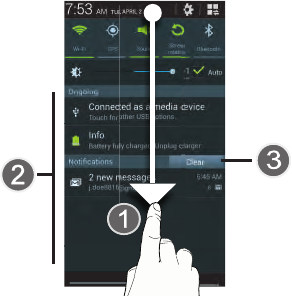
Understanding Your Phone 33
Notifications
Notifications shows information about connections, alerts
and other items.
1. Touch and drag downward from the top of the screen
to display notifications.
2. Touch an item to open that item, or to launch a related
app or feature.
3. Touch
Clear
to clear all Notifications.
Quick Setting Bar
Touch the selected Quick Setting toggles at the top of the
Notifications screen to enable or disable frequently used
settings. The following toggles are the default Quick Setting
toggles:
•
Wi-Fi
: Turn Wi-Fi On or Off. (For more information about using
Wi-Fi, see
“Wi-Fi”
on page 126.)
•
GPS
: Turn Standalone GPS services on or off. (For more
information, see
“Location services”
on page 185.)
•
Sound
: Touch to switch between your sound settings, and the
two Silent modes, Mute and Vibrate. (For more information, see
“Volume”
on page 158.)
•
Screen rotation
: Enable or disable the Auto rotation setting, to
control whether the screen automatically updates when you
rotate the phone. (See
“Auto-rotate screen”
on page 156.)
•
Bluetooth
: Turn Bluetooth On or Off. (For more information about
using Bluetooth, see
“Bluetooth”
on page 128.)
DRAFT
FOR INTERNAL USE ONLY
34
Changing Quick Settings Bar
You view and use all of the available Quick Setting toggles,
and select which toggles appear at the top of the
Notifications screen.
1. Display the notifications panel by touching and
dragging downward from the top of the screen.
2. Touch . The Notifications are replaced by an array
of the available Quick Setting toggles.
3. Touch and drag a Quick Setting toggle from rows 2, 3,
or 4 and drop it over the Quick Setting toggle in row 1
that you want to replace.
Clearing Notifications
1. Sweep your finger downward from the top of the
screen to display Notifications.
2. Touch a notification to clear it, or to launch an app.
– or –
Touch
Clear
to clear all notifications
DRAFT
FOR INTERNAL USE ONLY
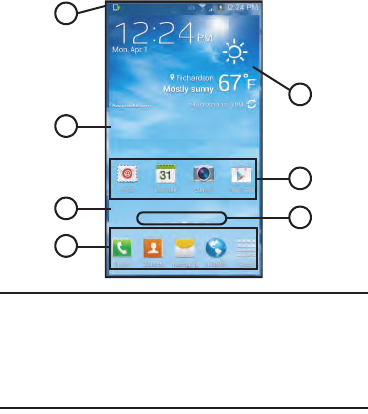
Understanding Your Phone 35
Home Screen
The Home screen is the starting point for using your phone.
Note:
Unless stated otherwise, instructions in this User Manual
start with the phone unlocked, at the Home screen.
All screen images in this manual are simulated. Actual
displays may vary, depending on the software version of
your phone and any changes to the phone’s Settings.
1.
Status Bar
: Presents icons to show network status,
battery power, and connection details. (For a list of
icons, see “Status Bar Icons” on page 36.)
2.
Multi window tab
: Access Multi window tray. (See
“Using Multi Window” on page 28.)
3.
Home screen
: The starting point for using your phone.
Place shortcut icons, widgets, and other items to
customize your phone to your needs. (See “Home
Screen” on page 35.)
4.
Primary Shortcuts
: Shortcuts to your phone’s common
apps. (See “Primary Shortcuts” on page 39.)
5.
Panel Indicator
: Shows what panel of 7 available Home
screen panels appears in the display.
6.
Shortcuts
: Shortcuts to common apps.These shortcuts
are found on the Home screen by default, and you can
add more shortcuts to your favorite apps. (See
“Shortcuts” on page 40.)
7.
Widget
: Apps that run on the Home screen. This widget
is found on the Home screen by default, and you can
add your favorites. (See “Widgets” on page 39.)
1
3
4
5
6
7
2
DRAFT
FOR INTERNAL USE ONLY
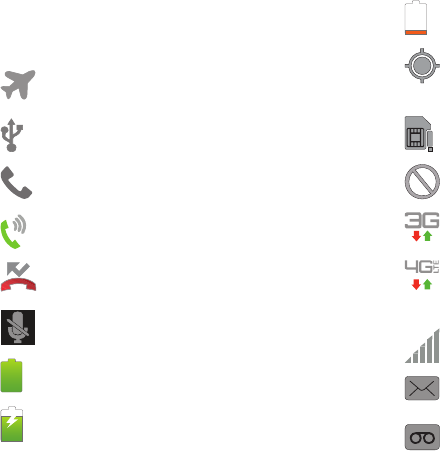
36
Status Bar Icons
The Status Bar shows network and battery status and other
details.
Airplane Mode Active
: All wireless communications
are disabled. See “Airplane mode” on page 145.
USB Connected
: The phone is connected to a
computer using a USB cable.
Voice Call
: A voice call is in progress.
Speakerphone
: Speakerphone is enabled.
Missed Call
: Displays when there is a missed call.
Mute
: Voice or playback volume is muted.
Battery Level
: Shown fully charged.
Battery Charging
: Battery is charging.
Device Power Critical
: Battery has very little power
remaining. Charge immediately.
GPS Location Active
: One or more GPS location
services are active. See “Location services” on
page 185.
Missing SIM
: No LTE SIM is installed.
No Network
: No wireless network is available.
3G connection
: Phone is active on a 3G system.
4G LTE Connection
: Phone is active on a 4G LTE
system.
Signal Strength
: Current signal strength. The
greater the number of bars, the stronger the signal.
New Message
: You have new message(s).
New Voicemail
: You have new voicemail. A number
indicates the number of new messages.
DRAFT
FOR INTERNAL USE ONLY

Understanding Your Phone 37
Display settings
You can customize display settings to your preferences. For
more information, see “Display” on page 154.
Extended Home Screen
The Home screen consists of the Home panel, plus panels
that extend beyond the display width to provide more space
for adding shortcuts, widgets and folders.
Slide your finger horizontally across the screen to scroll to
the left or right side panels. As you scroll, the indicator at the
bottom of the display shows your current position.
New Email Message
: You have new email.
Silent mode
: All sounds except media and alarms
are silenced, and Vibrate is not active. See
“Volume” on page 158.
Vibrate
: All sounds are silenced, and Vibrate is
active. See “Vibrations” on page 159.
SD Card Ready
: A memory card scan is underway,
to prepare the card for use.
SD Card Removed
: A memory card was un-installed.
Bluetooth Active
: Bluetooth is turned on.
Bluetooth Connected
: Your device is connected with
another Bluetooth device.
Wi-Fi Active
: Wi-Fi is active, and connected to a Wi-
Fi network.
Wi-Fi Action Needed
: Action needed to connect to
Wi-Fi network. For more information about
configuring Wi-Fi, see “Wi-Fi Settings” on
page 140.
TTY
: TTY Mode is active.
DRAFT
FOR INTERNAL USE ONLY

38
Customizing the Home Screen
Customize the Home screen to suit your preferences.
•
Add Shortcuts
: For more information, see
“Shortcuts”
on
page 40.
•
Add Widgets
: For more information, see
“Widgets”
on page 39.
•
Add Folders
: For more information, see
“Folders”
on page 40.
•
Change the Wallpaper
: For more information, see
“Wallpaper”
on page 41.
Adding and removing Home screen panels
Your phone comes with 7 Home screen panels. You can
customize the Home screen to include up to the seven
default panels, and set one panel as Home.
1. From the Home screen, touch
Menu
, then touch
Edit page
.
2. Slide your finger across the screen to scroll the panels,
and use these controls to configure panels:
Tip:
You can also “pinch” the Home screen to display Edit
options.
Remove
: Touch and hold on a panel, then drag
it
to
Remove
.
Add
: Touch a previously-removed panel to add
it, up to the default total of six.
Change panel sequence
: Touch and drag panels
to different positions.
DRAFT
FOR INTERNAL USE ONLY

Understanding Your Phone 39
Primary Shortcuts
Primary Shortcuts appear at the bottom of the display. You
can edit the Primary Shortcuts, except for
Apps
.
Editing the Primary Shortcuts
To add or remove shortcuts:
Touch and hold a shortcut, then drag it from the
Primary Shortcuts to the Home screen, or from the
Home screen to the Primary Shortcuts.
To remove shortcuts:
Touch and hold the shortcut until
Remove
appears,
then drag the shortcut to the
Remove
icon.
Widgets
Widgets are self-contained applications that you can place
on the Home screen for quick, direct access.
Adding Widgets to the Home screen
1. Press the
Home
key, swipe to a Home screen
panel, then touch and hold on the screen to display the
Home
screen
menu.
2. Touch
Add to Home screen
, then select
Apps and
widgets
.
3. Touch the
Widgets
tab, then touch a widget and follow
the prompts to configure the widget and place it on the
Home screen.
Adding Widgets from Apps
1. Press the
Home
key, and swipe to a Home
screen panel.
2. Touch
Apps
, then touch the
Widgets
tab.
3. Touch a widget, then follow the prompts to configure
the widget and place it on the Home screen.
Removing Widgets
Touch and hold the widget until
Remove
appears,
then drag the widget to the
Remove
icon.
DRAFT
FOR INTERNAL USE ONLY

40
Shortcuts
Use App shortcuts to launch applications from the Home
screen. Your phone comes with app shortcuts already placed
on the Home screen, and you can add your favorites.
Adding Shortcuts to the Home Screen
Adding shortcuts from the Home screen
1. Press the
Home
key, then touch and hold on
the screen to display the
Add to Home
screen
menu.
2. Touch
Apps and widgets
➔
Apps
tab, then touch a
selection.
3. Follow the prompts to configure the shortcut and add it
to the Home screen.
Adding Shortcuts from Apps
1. Press the
Home
key.
2. Touch
Apps
.
3. Touch and hold on an app until it appears on the Home
screen.
Removing Shortcuts
Touch and hold the shortcut until
Remove
appears,
then drag the shortcut to the Remove icon.
Folders
Place folders on the Home screen to organize items.
Adding Folders
1. Press the
Home
key.
2. Touch and hold on the screen to display the
Home
screen
menu, then under
Add to Home screen
touch
Folder
.
– or –
Touch
Menu
➔
Create folder
.
3. The folder appears on the Home screen. Touch the
folder to name it.
Removing Folders
Touch and hold the folder until
Remove
appears,
then drag the folder to the Remove icon.
DRAFT
FOR INTERNAL USE ONLY

Understanding Your Phone 41
Wallpaper
Choose a picture to display in the background of the Home
screen. You can choose from pre-loaded wallpaper images,
or select a picture you’ve taken with the Camera or
downloaded.
1. Press the
Home
key, touch and hold on the
screen to display the
Home
screen
menu, then select
Set wallpaper
➔
Home screen
/
Lock screen
/
Home and
lock screens
.
2. Choose a source:
•Gallery
: Choose a picture stored on your phone or on an
optional installed memory card. Touch a picture to select it,
then use the crop tool to resize the picture, if desired. Touch
Done
to save the picture as wallpaper.
•Live wallpapers
: Choose from pre-loaded animated wallpaper
images. Touch a wallpaper, then touch
Set wallpaper
.
• Wallpaper
: Choose from pre-loaded wallpaper images. Touch
a wallpaper, then touch
Set wallpaper
.
Tip:
You can also set Wallpaper in Settings. (For more
information, see “Wallpaper” on page 154.)
Apps
Apps holds all applications installed on your phone.
Applications that you download and install from the Google
Play™ Store or from the web are also added to Apps.
The Apps screen is like the Home screen, it consists of
panels that extend beyond the display width to provide more
space. Slide your finger horizontally across the screen to
scroll to the left or right side panels. As you scroll, the
indicator at the bottom of the display shows your current
position.
(For more information about applications, see “Applications
and Widgets” on page 82.)
You can place shortcuts to apps on the Home screen, for
quick access to the app. (For more information, see “Adding
Shortcuts from Apps” on page 40.)
1. Press the
Home
key, then touch
Apps
.
2. Slide your finger left or right to scroll the Apps screens.
3. Touch an icon to launch the application.
DRAFT
FOR INTERNAL USE ONLY

42
Customizing the Apps Screens
Choosing a view
By default, app icons appear in Grid view. You can change
the view to list view.
1. Press the
Home
key, then touch
Apps.
2. Touch
Menu
➔
View type
.
3. Choose an option:
• Customizable Grid
: The default view, which allows you to
touch and hold on apps to move them from screen to screen.
• Alphabetical grid
: Icons are arranged in a grid, in A-Z order.
• Alphabetical list
: Icons display in a list, sorted from A-Z.
Apps screen options
1. Press the
Home
key, then touch
Apps.
2. Touch
Menu
for options:
•Play Store
: Launch Google Play
™
Store, to browse for new
apps to download.
•Edit
: Touch and hold an app icon for these options:
–
Drag it to a new location.
–
Drag it to to create a new folder to contain the icon.
–
Drag it to to create a new apps screen and place the icon
on it.
–
Drag it to to launch Application manager to view information
about the app. For more information, refer to
“Application
manager”
on page 189.
–
Drag to (if available) to remove the icon. The trashcan is
only available for apps you’ve installed. Pre-loaded apps cannot
be removed.
• Create folder
: Add folders in which to group your apps.
• Uninstall
: Remove an app that you downloaded from your
phone. Pre-loaded apps cannot be un-installed.
• Downloaded applications
: Display all apps you’ve
downloaded.
DRAFT
FOR INTERNAL USE ONLY
Understanding Your Phone 43
•View type
: Configure the apps screen.
• Share apps
: Select apps you’ve downloaded (not available for
pre-loaded apps) to share via Bluetooth, Dropbox, Email,
Flipboard, Gmail, Google+, Messaging, S Memo, Wi-Fi Direct.
• Hide applications
/
Show hidden applications
: Control
whether app icons are visible in Apps. Hiding an icon does not
remove the app from your phone.
Entering Text
This section describes how to enter words, letters,
punctuation, and numbers when you need to enter text.
Text Input Methods
There are three text input methods available:
•
Google Voice typing
: allows you to enter text by speaking.
•
Samsung keyboard (default)
: Samsung’s on-screen
QWERTY keypad that can be used in both portrait and
landscape orientation.
•
Swype
: a new way to enter text on touch screens. Instead
of tapping each key, use your finger to trace over each
letter of a word.
(To change the input method, see “Keyboards and input
methods” on page 168.)
DRAFT
FOR INTERNAL USE ONLY

44
Entering Text Using the Samsung Keyboard
From a screen where you can enter text, rotate your phone
counterclockwise to a Landscape orientation. The on-screen
QWERTY keypad will display.
Changing the Text Input Mode - Keypad
There are two main keypad layout keys that will change the
on-screen keys within the QWERTY keypad.
The available Text Input modes are:
Sym
and
Abc
.
Note:
When in
Abc
mode, the
Sym
button will appear. When in
Sym
mode, the
Abc
/
ABC
/
abc
button will appear.
Using ABC Mode
1. If desired, rotate your phone counterclockwise to a
Landscape orientation.
2. When you tap the
Enter message
field, the following
screen displays:
New
Paragraph
Text Input Mode
Shift
Key Delete
Key
Space Bar
Voice Typing
and Settings
Symbol/Numeric Mode
: activates the number,
symbol, and emoticon keys.
ABC Mode
: activates the default alphabet keys.
Can also be set to
Abc
or
abc
by using the shift
() key.
DRAFT
FOR INTERNAL USE ONLY

Understanding Your Phone 45
3. Tap the desired alphabetic characters.
4. The screen initially opens in ABC mode. After typing the
first letter, the shift key ( ) will change to
and following letters will be lowercase.
5. Tap to input another upper-case letter or tap
twice to switch to ABC mode. The shift key will
change to in ABC mode. All following letters
will be uppercase until you tap the shift key again.
Using Symbol/Numeric Mode
Use Symbol/Numeric Mode to add numbers, symbols, or
emoticons.
1. Rotate your phone counterclockwise to a Landscape
orientation.
2. Tap at the bottom of the screen. The following
screen displays:
3. Tap the desired number, symbol, or emoticon
characters.
4. Tap the button to access additional symbols.
5. Tap to return to Abc mode.
Predictive Text
By using the Predictive Text option, you can have next-letter
prediction and regional error correction, which compensates
for pressing the wrong keys on the QWERTY keyboard.
Predictive text is turned on by default.
1. Press and hold on the keyboard, then tap .
2. Tap the ON/OFF slider, located to the right of the
Predictive text
field, to .
DRAFT
FOR INTERNAL USE ONLY

46
3. In the text portion of the message screen, begin typing
a word. A list of word options is displayed. Tap one of
the words to replace the word that has already been
typed or scroll the line of words to the left for more
word choices.
4. Continue typing your message. Tap to send the
message or press for more options. (For more
information, refer to “Creating and Sending Messages”
on page 73.)
Note:
You can also use Predictive Text mode in the portrait
orientation.
Entering Text Using Handwriting
You can enter text simply by using your finger to handwrite
letters on your screen.
1. Press and hold on the keyboard, then tap .
2. From the keypad, tap .
3. Use your finger tip to write out each character. You can
print or use cursive.
4. You can write out your entire message using the
Handwriting feature or tap to switch back to
Samsung keyboard mode.
Samsung Keyboard Settings
For information on how you can configure your Samsung
keyboard settings, see “Keyboards and input methods” on
page 168.
DRAFT
FOR INTERNAL USE ONLY

Understanding Your Phone 47
Using the Google Voice Typing Feature
You can use your voice to enter text using the Google Voice
typing feature.
1. Tap on the keyboard.
2. At the
Speak now
prompt, speak clearly and distinctly
into the microphone.
3. If the red microphone turns gray, then the feature has
timed out and you should tap the microphone icon to
start again.
The text is displayed in the message as you are
speaking.
4. Tap to return to the keyboard.
Note:
The feature works best when you break your message
down into smaller segments.
Entering Text Using Swype
Swype™ is a text input method that allows you to enter a
word by sliding your finger or stylus from letter to letter,
lifting your finger between words. Swype uses error
correcting algorithms and a language model to predict the
next word. Swype also includes a tapping predictive text
system.
The following example shows how to enter the word “This”.
Put your finger down on the “T”, and without lifting, glide it
to the “h”, then to the “i” then over to the “s”.
DRAFT
FOR INTERNAL USE ONLY

48
Enabling and Configuring Swype
The Samsung keyboard is the default text input method, so
to use Swype, you must first change the default keyboard
setting.
To enable Swype:
1. From a screen where you can enter text, touch and
drag down from the Notifications area then tap
Select input method
.
2. Tap the
Swype
radio button. It will turn green.
The Swype keyboard is displayed.
Swype Settings
For information on how you can configure your Swype
settings, see “Keyboards and input methods” on page 168.
Swype Text Entry Tips
You can access the SwypeTips application and watch a video
or tutorial on using Swype. You can also use the following
Swype text entry tips.
•
Create a squiggle (like an S shape) to create a double letter (such
as pp in apple).
•
Touch and hold a key to view the punctuation menu then make a
selection.
•
Move your finger or stylus over the apostrophe to enter
contractions.
•
Double-tap on the word you want to change to correct a
misspelled word, then tap the delete key to erase one character.
Touch and hold the delete key to erase an entire word.
DRAFT
FOR INTERNAL USE ONLY

Accounts and Contacts 49
Section 3: Accounts and Contacts
Accounts
Your phone provides the ability to synchronize information,
from a variety of accounts, including Email, Facebook,
Google, and your Samsung account. Depending on the
account, you can choose to synchronize your calendar,
contacts, and other types of content.
Contacts from your accounts appear in your phone’s
Contacts.
With synchronization, you can ensure that information on
your phone is updated with any information that changes in
your accounts.
Setting Up Your Accounts
Set up and manage your accounts with the
Accounts
settings.
(For information about setting up other, non-synchronized
email accounts, see “Configuring Email Accounts” on
page 78.)
Tip:
For more information on setting up your email, contact
your Wireless Provider.
Adding an account
1. From the Home screen, touch
Menu
, then touch
Settings
➔
Accounts
.
2. Under
My accounts
, touch
Add account
.
3. Select an account type, then follow the prompts to
enter your credentials and sign in.
4. The phone communicates with the provider’s server to
set up your account on the phone.
DRAFT
FOR INTERNAL USE ONLY

50
Controlling Synchronization
You can choose to have your phone automatically
synchronize with your accounts, or manually synchronize
each account when you want to check messages.
You may also choose to limit automatic or background
synchronization to extend battery life.
1. From the Home screen, touch
Menu
, then touch
Settings
➔
Accounts
.
2. Under
My accounts
, touch the desired account type.
The related account type screen appears.
3. Under
Accounts
, touch the desired account ID. The
Sync settings
screen for the selected account appears
listing some or all of the following synchronization
settings:
•Sync Calendar
•Sync Contacts
• Sync Email
•Sync Gmail
• Sync Google Photos
• Sync Google Play Books
• Sync Google Play Magazines
• Sync Google Play Movies & TV
• Sync Google Play Music
• Sync Internet
• Sync Picasa Web Albums
• Sync Tasks
4. Touch these settings to enable/disable synchronization
of the associated file types. When enabled, a check
mark appears in each setting check box.
•
With automatic synchronization enabled, your phone
automatically synchronizes its related files with similar files on
on-line file servers.
•
With automatic synchronization disabled, you can manually
sync accounts by touching
Sync all
in the account type screen
for each account.
Tip:
You can control automatic synchronization using the
Sync
toggle in the Quick Settings menu on the Notifications
screen. (For more information, refer to “Quick Setting
Bar” on page 33.)
DRAFT
FOR INTERNAL USE ONLY

Accounts and Contacts 51
Google Account Privacy Settings
Personalize the Privacy settings for Google accounts:
1. From the Home screen, touch
Menu
, then touch
Settings
➔
Accounts
.
2. Under
My accounts
, touch
Google
. The
Google
account
type screen appears.
3. Under
Privacy
, the following options are available:
•Maps & Latitude
: Tailor
Location settings
for Google
accounts.
•Search
: Manage Google accounts location histories and
search histories.
• Location settings
: Choose whether Google apps can access
location information for Google accounts.
• Google+
: Manage Google+ information for Google accounts.
•Ads
: Choose whether to personalize Google and AdMob
advertisements for Google accounts.
Managing accounts
1. From the Home screen, touch
Menu
, then touch
Settings
➔
Accounts
.
2. Under
My accounts
, touch the desired account type.
The related account type screen appears.
3. Under
Accounts
, touch the desired account ID. The
Sync settings
screen for the selected account appears.
(For more information, refer to “Controlling
Synchronization” on page 50.)
4. To enable or disable a synchronization setting, touch it.
When enabled, a check mark appears in the check box.
5. To invoke the enabled synchronization settings for the
selected account, touch
Sync now
.
6. To remove the selected account from your phone,
touch
Remove account
. A
Delete account?
pop-up
prompts you to confirm the removal.
To remove the selected account, touch
Remove
account
.
DRAFT
FOR INTERNAL USE ONLY

52
Contacts
To access Contacts:
From the Home screen, touch
Contacts
.
Contact tips:
•
Swipe your finger left-to-right across a contact to make a call to
the contact.
•
Swipe right-to-left across a contact to create a message
addressed to the contact.
Adding Contacts
1. From the Home screen, touch
Contacts
➔
Add contact
.
•
If you have defined accounts (Google, Samsung, and so on),
the
Save contact to
pop-up appears. Select
Phone
or the
account to receive the new Contact entry.
•
If you have not defined any accounts, the
Save contact
pop-
up appears. The following options are available:
–
OK
: Saves your contacts in
“my device contacts”
.
–
Add new account
: Lets you define an account to which your
device will save your contacts. The
Add new account
screen
appears. (For more information, refer to
“Setting Up Your
Accounts”
on page 49.)
2. Touch contact fields to select or enter information:
•
Touch
Add photo ID
to choose a picture to identify the
contact.
•
Touch
Name
to enter a name for the contact. Touch to
enter
Name prefix
,
First
name
,
Middle name
,
Last name,
or
Name suffix
.
•
Touch
Phone number
to enter a phone number, then touch the
Label
button to choose a label, from
Mobile
,
Home
,
Work
,
Work Fax
,
Home Fax
,
Pager
,
Other
,
Custom
, or
Callback
. To
add another number, touch .
•
Touch
Email address
to enter an email address, then touch the
Label
button to choose a label, from
Home
,
Work
,
Other
, or
Custom
to create a new label. To add an address, touch .
•
Touch
Address
to enter a street or postal address, then touch
the
Label
button to choose a label, from
Home
,
Work
,
Other
,
or
Custom
to create a new label. To add an address, touch
.
•
Touch next to
Events
to enter a special date, then touch
the
Label
button to choose a label, from
Birthday
,
Anniversary
,
Other
, or
Custom
to create a new label.
DRAFT
FOR INTERNAL USE ONLY

Accounts and Contacts 53
•
Touch
Groups
to assign the contact to a group. For more
information about Groups, see
“Groups”
on page 59.
•
Touch
Ringtone
to choose a ringtone for the contact.
•
Touch
Message alert
to select the alert tone to be played when
you receive a message from this contact.
•
Touch
Vibration pattern
to choose a vibration pattern to play
when you receive a call or message from this contact.
•
Touch
Add another field
to add more fields, including
Phonetic Name
,
Organization
,
IM
,
Notes
,
Nickname
,
Website
, or
Relationship
.
3. When you finish selecting and entering information,
touch
Save
.
Creating Contacts from Recent calls
Save a phone number from a recent call to create a new
contact, or update an existing contact.
For more information, refer to “Creating or Updating Contacts
Using Recent calls” on page 67.
Creating Contacts from the Phone Keypad
Enter a phone number with the Phone Keypad, then save it.
1. From the Home screen, touch
Phone
.
2. Touch the digits of the phone number on the
Keypad
.
3. Touch
Add to Contacts
, then select
Create contact
from
the pop-up menu.
4. Continue entering contact information. (For more
information, refer to “Adding Contacts” on page 52.)
Tip:
While entering a phone number, you can add waits or
pauses. Enter the number up to the pause or wait, then
touch
Menu
to select
Add 2-sec pause
or
Add wait
.
DRAFT
FOR INTERNAL USE ONLY

54
Updating Contacts
Make changes to update an existing contact.
1. From the Home screen, touch
Contacts
.
2. Touch a contact to view its information, then touch
Edit
.
– or –
Touch and hold a contact, then select
Edit
from the
menu.
3. Continue entering contact information. (For more
information, refer to “Adding Contacts” on page 52.)
Updating Contacts from the Phone Keypad
Enter a phone number with the Phone Keypad, then save it.
1. From the Home screen, touch
Phone
.
2. Touch the digits of the phone number on the
Keypad
.
3. Touch
Add to Contacts
, then select
Update existing
from
the pop-up menu.
4. Select a contact to update, then continue entering
contact information. (For more information, refer to
“Adding Contacts” on page 52.)
Updating Contacts from Recent calls
Save a phone number from a recent call to create a new
contact, or update an existing contact.
For more information, refer to “Creating or Updating Contacts
Using Recent calls” on page 67.
Choosing Contacts to Display
1. From the Home screen, touch
Contacts
.
2. Touch
Menu
, then touch
Contacts to display
:
•
Choose
All contacts
to show all contacts.
•
Touch
Device
to show only show contacts saved to the phone.
•
Choose an account to only display contacts from that account.
•
Choose
Customized list
to select contact types for each
account, or the phone.
DRAFT
FOR INTERNAL USE ONLY

Accounts and Contacts 55
Contacts Settings
1. From the Home screen, touch
Contacts
.
2. Touch
Menu
, then touch
Settings
:
•
Select
Only contacts with phones
to show contacts with at
least one stored phone number.
•
Touch
List by
to sort contacts by first or last name.
•
Touch
Display contacts by
to list contacts by first or last name.
•
Touch
Contact sharing settings
to set your preference for
sending contacts namecards to other accounts or devices. (For
more information about sending contacts, see
“Sending
Namecards”
on page 58.)
Other Contacts Options
1. From the Home screen, touch
Contacts
.
2. Touch a contact to display it, then touch
Menu
:
•History
: View calls and messages to and from this contact.
•Edit
: Modify contact information. (For more information, refer to
“Updating Contacts”
on page 54.)
• Delete
: Erase the contact record.
•Join contact
/
Separate contact
: Manage multiple contacts
as one. (For more information, refer to
“Joining Contacts”
on
page 57.)
• Mark as default
: Set a default phone number or other field
(such as IM or email address). Defaults are the contact method
used when creating a message or calling a contact. You can
also set a default by touching and holding on a contact field.
• Share namecard via
: Send the namecard. (For more
information, refer to
“Sending Namecards”
on page 58.)
• Add to reject list
: Mark the contact so that calls or messages
from the contact are rejected automatically. To remove a
contact from the reject list, touch and hold on the contact in the
main contacts screen, then choose
Delete from reject list
.
DRAFT
FOR INTERNAL USE ONLY

56
• Print contact info
: Print the namecard via Bluetooth to a
compatible Samsung Bluetooth-enabled printer.
• Add shortcut to Home
: Add shortcut to this contact to Home
screen.
My Local Profile
My local profile is your own contact record, listed under
ME
in Contacts. You can send My local profile as a vCard via
Bluetooth or as an attachment to messages.
Creating My Local Profile
1. From the Home screen, touch
Contacts
.
2. Under
ME
touch your Google account name or
Set up
profile
.
3. Enter your information in the contact fields.
(
For more
information, refer to “Adding Contacts” on page 52.)
Sending My Local Profile
You can send your profile as a vCard via Bluetooth to other
Bluetooth devices, or as an attachment.
1. From the Home screen, touch
Contacts
.
2. Touch your profile to display your contact information.
3. Touch
Menu
, then touch
Share namecard via
.
4. Choose a sending method or app from the
Complete
action using
pop-up, then follow the prompts to send
the profile.
DRAFT
FOR INTERNAL USE ONLY

Accounts and Contacts 57
Joining Contacts
Your phone can synchronize with multiple accounts,
including Google, Corporate, and other providers, plus social
networking sites like Facebook. When you synchronize
contacts from these accounts with your phone, you may have
multiple contacts for one person.
Joining contact records allows you to see all the contact’s
numbers and addresses together. Joining also helps you
keep your contacts updated, because any changes to
information in the respective accounts is automatically
updated the next time you synchronize with the account.
Joining contacts
1. From the Home screen, touch
Contacts
.
2. Touch a contact to display its information.
3. Touch
Menu
, then touch
Join contact
. A list of
available contacts appears.
4. Select a contact to join to the displayed contact. The
joined contact appears.
5. To join another contact, touch the
Connection
field. The
Joined contact screen appears.
Touch
Join another contact
. A list of available contacts
appears.
Select a contact to join to the displayed contact. The
joined contact appears.
Separating contacts
1. From the Home screen, touch
Contacts
.
2. Touch a contact to display its information.
3. Touch the
Connection
field to display joined contacts.
4. Touch to the right of a contact to remove it from
the selected joined contact.
DRAFT
FOR INTERNAL USE ONLY

58
Exporting and Importing Contacts
You can export your contact list to an installed memory card,
or import a list of contacts (previously exported) from a
memory card.
1. From the Home screen, touch
Contacts
.
2. Touch
Menu
, then touch
Import/Export
.
3. Select an option, then follow the prompts to complete
the operation:
• Import from USB storage
: Copy contacts that are saved in
installed mass storage.
• Export to USB storage
: Copy contacts to installed mass
storage.
• Import from SD card
: Copy contacts that are saved on an
installed memory card.
• Export to SD card
: Copy contacts to an installed memory card.
• Share namecard via
: Share contacts as Namecards. (For
more information, refer to
“Sending Namecards”
on page
58.)
Sending Namecards
You can send a contact entry as a namecard using a
Bluetooth connection to another device, or as an attachment
to a Gmail or Email message.
Important!
Not all Bluetooth devices will accept contacts, and
not all devices support transfers of multiple
contacts. Check the target device’s documentation.
1. From the Home screen, touch
Contacts
.
2. Touch
Menu
, then touch
Import/Export
➔
Share
namecard via
.
3. Touch contacts to mark them for sending, or touch
Select all
to mark all contacts. A check mark appears in
the check box for marked contacts.
4. Touch
Done
.
5. Choose a sending method or app from the
Complete
action using
pop-up, then follow the prompts to send
the profile.
DRAFT
FOR INTERNAL USE ONLY

Accounts and Contacts 59
Favorites
Mark contacts with a
star to identify them as Favorites.
Favorites display on the
Favorites
tab in the
Phone
and
Contacts
screens for fast dialing or messaging, and are
indicated by the .
Creating Favorites
1. From the Home screen, touch
Contacts
.
2. Touch and hold on a contact, then select
Add to
favorites
from the pop-up menu.
– or –
Touch a contact to display it, then touch at the top
right of the screen, it changes color to .
Groups
Assign contacts to Groups to make searching for contacts
faster, or to quickly call or send messages to group
members. Your phone comes with pre-loaded groups you
can use to add your contacts.
Adding a New Group
1. From the Home screen, touch
Contacts
➔
Groups
.
2. Touch
Menu
➔
Create
, then enter information:
•
Touch
Group name
to enter a Group Name.
•
Touch
Group ringtone
to choose a ringtone for calls from
members of this group.
•
Touch
Vibration pattern
to choose a vibration to play for calls
from members of this group.
•
Touch
Add member
to select members from Contacts.
3. Touch
Save
to save the new group.
DRAFT
FOR INTERNAL USE ONLY

60
Editing a Group
1. From the Home screen, touch
Contacts
➔
Groups
.
2. Touch a Group to display it.
3. Touch
Menu
➔
Edit
, then update information for
the group. For more information, see “Adding a New
Group” on page 59.
Deleting a Group
Tip:
You can only delete groups that you have created.
1. From the Home screen, touch
Contacts
➔
Groups
.
2. Touch
Menu
➔
Delete groups
.
3. Touch a Group to mark it for deletion, or touch
Select all
to mark all groups. When selected, a check mark
appears in the check box. You cannot delete pre-
loaded groups.
4. Touch
Delete
, then choose
Group only
or
Group
and
group members
.
Adding Contacts to a Group
1. From the Home screen, touch
Contacts
➔
Groups
.
2. Touch a Group to display it, then touch .
3. Touch contact(s) to mark them for addition, or touch
Select all
to mark all contacts. When selected, a check
mark appears in the check box.
4. Touch
Done
to add the selected contact(s).
Removing Contacts from a Group
1. From the Home screen, touch
Contacts
➔
Groups
.
2. Touch a Group to display it.
3. Touch
Menu
➔
Remove member
.
4. Touch contact(s) to mark them for removal, or touch
Select all
to mark all contacts. When selected, a check
mark appears in the check box.
5. Touch
Done
to remove the selected contact(s).
DRAFT
FOR INTERNAL USE ONLY

Accounts and Contacts 61
Sending a Message to Group Members
Create a new text or email message, addressed to the
group’s members.
1. From the Home screen, touch
Contacts
➔
Groups
.
2. Touch and hold a Group, then touch
Send message
or
Send email
.
3. Touch contacts to mark them as recipients for the new
message, then touch
Done
.
4. The new message opens, with the marked contacts as
recipients. Continue creating the message, as desired.
(For more information, refer to “Creating and Sending
Messages” on page 73, or “Composing and Sending
Email” on page 78.)
Speed Dials
Speed dials are 1-, 2-, or 3-digit shortcuts (1 to 100) you
assign to contacts, to allow you to quickly call the contact.
For more information about calling using speed dials, see
“Making Calls using Speed Dials” on page 62.
Note:
Speed dial 1 is reserved for Voicemail, and cannot be
assigned.
Assigning Speed Dials
1. From the Home screen, touch
Contacts
.
2. Touch
Menu
, then touch
Speed dial setting
.
3. A list of speed dials displays.Touch a speed dial, then
touch a contact to assign the speed dial to the contact.
Removing or Reassigning a Speed Dial
1. From the Home screen, touch
Contacts
.
2. Touch
Menu
, then touch
Speed dial setting
.
3. Touch and hold an assigned Speed dial setting, the
following options pop-up:
• Replace
: Touch a new speed dial location to assign it to the
contact.
• Delete
: Un-assign the speed dial from the contact.
DRAFT
FOR INTERNAL USE ONLY

62
Section 4: Calling
Making Calls
Your phone offers multiple ways to make calls:
•
Use the touch screen
Phone Keypad
to enter the phone number
or speed dial.
•
Call a contact from
Contacts
.
•
Call a contact from
Favorites
.
•
Return a call, or call a recent caller, from
Recent
.
•
Voice dial using
Voice Dialer
.
Making Calls Using the Phone Keypad
1. From the Home screen, touch
Phone
.
2. Touch the digits of the telephone number on the
Keypad
.
3. Touch to place the call.
Making Calls using Speed Dials
Speed Dials are 1-, 2-, or 3-digit shortcuts (1 to 100) you
assign to contacts, to allow you to quickly call the contact.
(For more information about setting speed dials, see “Speed
Dials” on page 61.)
1. From the Home screen, touch
Phone
.
2. Touch the digits of the speed dial number on the
Keypad
, holding the last digit until the number dials.
DRAFT
FOR INTERNAL USE ONLY

Calling 63
Making Calls from Contacts
A contact is an entry that you have created to store the
name, numbers, and other information for people or groups
of interest.
(For more information, refer to “Contacts” on page 52.)
1. From the Home screen, touch
Contacts
.
2. Find the contact and touch it to open the Contact entry.
3. Swipe your finger from left to right across the contact
to dial their default number.
– or –
Touch a contact, then touch to dial the number.
Making Calls using S Voice
Place a call by speaking the name or number.
1. From the Home screen, touch
Phone
. then touch
S Voice
.
2. The first time you access S Voice, follow the prompts to
confirm the license agreement, and view information
about S Voice.
3. Follow the prompts to speak a command. You can say
commands such as:
• Call <Name >
: Call an entry in your Contacts list.
• Dial <Phone number>
: Call a spoken phone number.
•Redial
: Repeat a recent call.
DRAFT
FOR INTERNAL USE ONLY

64
Making Calls using Favorites
Favorites are contacts that you designate as favorites by
starring them. (For more information about creating favorites,
see “Favorites” on page 59.)
1. From the Home screen, touch
Phone
.
2. Touch
Favorites
to display favorites.
3. Find the contact and touch it to open the Contact entry.
4. Swipe your finger from left to right across the contact
to dial their default number.
– or –
Touch a contact, then touch to dial the number.
Making Calls from Recent calls
Return a call, or call a number from a recent call stored in
Recent calls.
(For more information, refer to “Recent Calls” on page 66.)
Multi-party Calling
Use multi-party call features to set up a call between multiple
callers, such as for a conference call.
1. Establish the first call, by answering an incoming call
or making a call.
2. Touch
Add call
. The first call is placed on hold.
3. Make the second call by touching the phone number
digits, then press .
4. Touch Merge to merge the calls into one conference
call.
5. To end the call touch
.
DRAFT
FOR INTERNAL USE ONLY

Calling 65
Answering Calls
You can answer incoming calls when the phone is locked or
unlocked.
Touch and drag the
Answer
icon to the right.
Tip:
To silence the ringtone for an incoming call, press the
Volume
key Up or Down.
Sending Calls to Voicemail
When your phone alerts you to an incoming call, you can
reject the call to send the caller to voice mail, or reject the
call and send a message to the caller.
Rejecting a call
Touch and drag the
Reject
icon to the left.
Rejecting a call with a message
Touch and drag
Reject call with message
toward the
middle of the screen, then select an existing message,
or
Create new message
.
Answering Call-Waiting Calls
When you receive a call while on a call:
•
Touch and drag the
Answer
icon to the right to answer the
incoming call. The original call is placed on hold, and remains on
hold until you end the second call, or swap calls back to the
original call.
•
Touch
Swap
to place a call on hold and return to the original call.
Note:
For more information about creating reject
messages, see “Set up call rejection messages”
on page 69.
DRAFT
FOR INTERNAL USE ONLY

66
Options During a Call
While in a call, you can use these features:
•
Add call
: Display the Dialer to set
up a multi-party call.
•
Keypad
: Display a keypad to enter
numbers.
•
End call
: End the phone call.
•
Speaker
: Enable or disable
speakerphone.
•
Mute
: Mute or unmute your voice
on the call.
•
Headset
: Switch the call’s audio to
a Bluetooth headset.
•
Touch
Menu
for options:
–
Contacts
: Launch Contacts.
–
Message
: Launch Messaging to view or create messages.
–
Memo
: Launch S Memo to take notes in text, or create a
drawing.
–
Noise reduction on/Noise reduction off
: Enable or disable noise
reduction, to improve call audio quality in noisy environments.
–
My call sound
: Apply a sound equalizer to the call audio, in
cases where you might need the sound softer or clear, or
optimized for your right or left ear.
Ending a Call
Touch .
Recent Calls
When you place, answer, or miss a call, a record of the call is
saved in Recent calls.
Accessing Recent calls
From the Home screen, touch
Phone
➔
Recent
to display recent calls.
Making Calls using Recent calls
1. From the Home screen, touch
Phone
.
2. Touch
Recent
to display recent calls.
3. Swipe your finger from left to right across the call to
redial.
– or –
Touch a call, then touch to dial the number.
DRAFT
FOR INTERNAL USE ONLY

Calling 67
Sending Messages using Recent calls
1. From the Home screen, touch
Phone
➔
Recent
.
2. Swipe your finger from right to left across the call.
– or –
For a contact call, touch the picture ID icon, then touch
to create a message to the number.
Creating or Updating Contacts Using Recent
calls
1. From the Home screen, touch
Phone
➔
Recent
.
2. Touch and hold on a call, then select
Add to Contacts
from the pop-up menu.
3. Choose
Create contact
or
Update existing
.
4. Continue entering contact information. (For more
information, see “Contacts” on page 52.)
Managing Recent calls
Deleting records
1. From the Home screen, touch
Phone
➔
Recent
.
2. While viewing the calls, touch
Menu
, then touch
Delete
.
3. Touch call records to mark them for deletion, or touch
Select all
. A check indicates marked records.
4. Touch
Delete
to delete marked records.
Filtering records
1. From the Home screen, touch
Phone
➔
Recent
.
2. While viewing the calls, touch
Menu
, then touch
View by
.
3. Select a filter type, from
All calls and messages
,
All calls
,
Missed calls
,
Dialed calls
,
Received calls
,
Rejected calls
,
All messages
,
Sent messages
, or
Received messages
.
DRAFT
FOR INTERNAL USE ONLY

68
Viewing call durations
View the length of the Last call, all Dialed calls, all Received
calls, or All calls.
1. From the Home screen, touch
Phone
➔
Recent
.
2. While viewing calls, touch
Menu
, then touch
Call duration
.
Call Settings
Configure settings for calling with your phone.
To access Call settings, from the Home screen, touch
Phone
➔
Menu
➔
Call Settings
.
Call rejection
Create and manage a list of phone numbers, to have your
phone automatically reject calls you receive from those
numbers.
From the
Call Settings
screen, touch
Call rejection
for
these options:
• Auto reject mode
: Touch
Auto reject mode
to turn
Auto reject ON, or touch
Auto reject mode
to turn
Auto reject OFF. When ON, calls from numbers on the Auto
reject list will be rejected.
• Auto reject list
: Enter telephone numbers to be rejected when
Auto reject mode is ON. Turn on
Unavailable
to reject calls with
no caller ID. Touch
Create
, then follow the prompts to enter
numbers to reject, or select them from Contacts. Touch
Match
criteria
to set options for using the reject number list.
DRAFT
FOR INTERNAL USE ONLY

Calling 69
Set up call rejection messages
Create and manage text messages to send to callers when
you select
Reject call with message
in the
Incoming call
screen.
1. From the
Call Settings
screen, touch
Set up call
rejection messages
.
2. Manage messages:
•
To create new rejection messages, touch
Create
, then follow
the prompts.
•
To modify an existing rejection message, touch the message,
then edit the text.
•
To erase an existing rejection message, touch , select the
message to be erased, then touch
Delete
.
Call answering/ending
Manage settings for answering and ending calls.
1. From the
Call Settings
screen, touch
Call answering/
ending
. The following options are available:
• Answering key
: When enabled, you can answer an incoming
call by pressing
Home
.
• The power key ends calls
: When enabled, pressing
Power/Lock
ends a call.
Auto screen off during calls
When enabled, the screen automatically turns off during
phone calls, and the proximity sensor on the front of the
phone is used to turn the screen back on when the phone is
moved or brought close to another surface, such as when
you move the phone to your ear.
From the
Call Settings
screen, touch
Turn off screen
during calls
to enable or disable the option.
DRAFT
FOR INTERNAL USE ONLY
70
Call alerts
Set options for sounds and vibrations to occur during calls.
From the
Call Settings
screen, touch
Call alerts
. The
following options are available:
• Call vibrations
: Enable
Vibrate on connection to network
to
have your phone vibrate when it connects to the network.
Enable on
Call-end vibration
to have the phone vibrate when
the other caller ends the call.
•Call status tones
: Choose options for sounds to play during
calls. Enable
Call connect tone
to have the phone play a tone
when the other caller answers a call. Enable
Minute minder
to
have a tone play once per minute during a call. Enable
Call end
tone
to have the phone play a tone when the other caller ends
the call. Touch
OK
to save the settings.
• Alerts during calls
: Enable to have notifications for alarms and
new messages play during phone calls. When disabled, these
notifications will be muted during a call.
Accessory setting for call
Configure headset options for calls.
From the
Call Settings
screen, touch
Accessory settings
for call
. The following options are available:
• Headset settings for incoming calls
:
–
Automatic answering
: When enabled, and you have a
headset connected to the Headset Jack, incoming calls are
answered automatically after a delay, set at Automatic
answering timer.
–
Automatic answering timer
: Choose a time period to delay
before automatically answering an incoming call when
Automatic answering is enabled and a headset is connected to
the phone.
• BT (Bluetooth) headset settings for outgoing calls
:
–
Outgoing call conditions
: When the phone is paired with a
Bluetooth headset, you can choose to make calls even when the
phone is locked.
DRAFT
FOR INTERNAL USE ONLY
Calling 71
Ringtones and keypad tones
Select incoming call ringtone and vibration, and enable or
disable call vibration and keypad tones.
From the
Call Settings
screen, under
Ringtone and
sound settings
, touch
Ringtones and keypad tones
. The
following options are available:
•Ringtones
: Select the ringtone your phone plays to alert you of
incoming calls.
•Vibrations
: Select the vibration pattern your phone uses to alert
you of incoming calls.
• Vibrate when ringing
: Touch to enable/disable use of your
selected
Vibrations
. When enabled, a check mark appears in
the check box.
• Keypad tones
: Touch to enable/disable playing of DTMF tones
when you enter numbers with the Phone keypad. When
enabled, a check mark appears in the check box.
Personalize call sound
When enabled, you can select a sound profile for use during
calls.
From the
Call Settings
screen, under
Ringtone and
sound settings
, touch
Personalize call sound
to Adapt
Sound, use Soft sound, use Clear sound, or use System
volume setting (Off).
Noise reduction
When enabled, the phone uses both of its microphones to
detect background noise from your environment and
suppress it during calls.
From the
Call Settings
screen, under
Ringtone and
sound settings
, touch
Noise reduction
to enable or
disable the option.
Increase volume in pocket
When enabled, the phone uses the proximity sensor to detect
when the phone is in a pocket or other close-fitting location
such as a purse or bag, and increases the volume for
incoming call ringtones.
From the
Call Settings
screen, touch
Increase volume in
pocket
to enable or disable the option.
DRAFT
FOR INTERNAL USE ONLY
72
Voicemail
Configure options for voicemail.
From the
Call Settings
screen, under
Voicemail
, the
following options are available:
• Voicemail service
: By default, your phone uses your wireless
service provider’s voicemail service. If you have another option
for voicemail installed, select it here.
• Voicemail settings
: By default, the speed dial for calling
voicemail (speed dial 1) is set to your phone number. If you wish
to use another Voicemail service, touch
Voicemail number
to
set a new one.
•Ringtone
: Choose sound to play for a voicemail notification.
•Vibrate
: Choose an option for vibration to play for a voicemail
notification.
Other call settings
From the
Call Settings
screen, under
Other call settings
,
the following options are available:
•Auto retry
: When enabled, the phone will automatically redial a
call if it receives a busy signal from the network.
• TTY mode
: Choose a TTY mode to enable TTY mode, for use
with optional TTY equipment.
•DTMF tones
: Set the length of Dual-tone Multi-frequency
tones, which play when you use the keypad during a call, such
as when navigating phone menus.
• Voice privacy
: Enable or disable Enhanced voice privacy, to
improve the security of phone calls.
DRAFT
FOR INTERNAL USE ONLY

Messaging 73
Section 5: Messaging
This section describes how to send and receive messages,
and other features associated with messaging.
Types of Messages
Your phone supports these types of messages:
•
Text messages
: Send and receive simple messages containing
text to other mobile phones or email addresses (also known as
SMS).
•
Multimedia messages
: Send and receive text messages with
pictures, video, and/or sound to other mobile phones or email
addresses (also known as MMS).
•
Mobile IMs
: Exchange Instant Messages with other users of
popular messaging sites.
•
Email
: Send and receive email from your email accounts,
including Corporate mail.
•
Gmail
: Send and receive Gmail from your Google account.
•
Voicemail
: Retrieve voice messages from callers.
•
Google Talk
: Chat with other Google Talk users.
Text and Multimedia Messaging
Your phone can send and receive text and multimedia
messages.
Creating and Sending Messages
1. From the Home screen, touch
Messaging
➔
New message
.
2. Touch
Enter recipient
and enter a name, phone number
or email address, or touch to add recipients from
Contacts. As you enter text, matching contacts appear.
Touch a contact to add it to the list.
3. Touch
Enter message
, then enter the message text. The
following options are available (which options are
available depends on whether you include an
attachment):
•
Touch
Attach
to add media (Image, Take a picture, Video,
Record video, Audio, Record audio files) or content (S Memo text,
Calendar events, Locations, Contacts) to the message (converts
the message to MMS).
DRAFT
FOR INTERNAL USE ONLY

74
•
Touch
Menu
for options:
–
Insert smiley
: Add a text emoticon to the message.
–
Add text
: Select text from S Memo, Calendar, Location,
Contacts or Text templates to add.
–
Preview
: View the message and attachments before sending.
–
Add to Contacts
: If the recipients are not saved in Contacts,
save the info as a new contact, or update an existing contact.
–
Add slide
/
Delete slide
: Add or remove a slide. Slides hold
pictures or other media (adding a slide converts the message to
MMS).
–
Add subject
: Add a subject field (converts the message to
MMS.)
–
Duration (5sec)
: Set the length of time the media on the slide
displays.
–
Layout (bottom)
: Choose whether the message text appears
above (Text on top) of the attachment(s), or after (Text on
bottom).
–
Scheduled message
: Select a delivery date and time.
–
Discard
: Erase this message.
–
Translate
: Launches the Translator app.
4. Touch to send the message.
Managing Messages
Messages you send and receive to the same contact, number
or address are grouped together as a “conversation”.
Threads allow you to see all the messages you exchanged
with a recipient in one place.
1. From the Home screen, touch
Messaging
.
2. Message threads display by contact, number, or
address. While viewing message threads, you have
these options:
•
Touch and hold a thread to choose options, including:
–
View Contact
/
Add to Contacts
: View the contact record, or
save the sender/recipient’s information.
–
Delete thread
: Erase the entire message thread.
–
Register number as spam
: Add this number to message
reject list. Messages from this number are automatically placed
in the Spam messages folder.
•
Touch
Menu
for options, including:
–
Search
: Enter characters to search messages and recipients.
–
Delete threads
: Touch message threads to mark them for
erasure, or touch
Select all
to mark all message threads.
DRAFT
FOR INTERNAL USE ONLY

Messaging 75
–
Draft messages
: Messages you have composed and saved for
later reuse and/or to be sent to a recipient.
–
Locked messages
: Messages you have locked to protect
them from accidental deletion.
–
Spam messages
: Messages received from numbers you have
registered as spam senders.
–
Settings
: Configure Messaging settings.
Message Settings
Configure settings for message storage, delivery, or alerts.
1. From the Home screen, touch
Messaging
.
2. Touch
Menu
, then touch
Settings
for options:
• General settings
:
–
Delete old messages
: When enabled, messages are
automatically erased when storage reaches default limits. When
disabled, the phone will prompt you to delete old messages to
make room.
–
Text message limit
: Set the number of SMS messages per
conversation.
–
Multimedia message limit
: Set the number of MMS
messages per thread.
–
Text templates
: Text templates are phrases that you can add
to your messages. Use a pre-loaded text template, or create
your own.
• Text message (SMS) settings
:
–
Delivery reports
: When enabled, you receive a delivery report
for text messages you send.
–
Auto combination
: When enabled, re-assembles multi-
segment messages and shows them as a single message.
DRAFT
FOR INTERNAL USE ONLY
76
• Multimedia message (MMS) settings
:
–
Delivery reports
: When enabled, you receive a delivery report
for multimedia messages you send.
–
Auto-retrieve
: When enabled, MMS messages download
automatically. When disabled, the phone prompts for download.
–
Roaming auto-retrieve
: When enabled, MMS messages
download and display automatically when roaming. When
disabled, the phone prompts you to download new MMS
messages.
–
MMS alert
: When enabled, alerts you when a message
changes mode to MMS.
•Display
:
–
Bubble style
: Choose the appearance of messages in a
message thread. Touch a bubble style for each side of the
conversation, then touch
Save
.
–
Background style
: Choose the appearance of the screen
behind message threads. Touch a style, then touch
Save
.
–
Use the volume key
: When enabled, you can change the size
of message text while viewing by pressing the Volume Key.
• Notification settings
:
–
Notifications
: When enabled, message alerts display in the
Status bar.
–
Select ringtone
: Choose a sound for message alerts.
–
Vibrate
: Configure vibration for message alerts.
–
Message alert repetition
: Choose to have message alert
repeat Once, Every 2 minutes, or Every 10 minutes.
–
Preview message
: When enabled, a preview of a received
message appears in the Status bar.
• Emergency message settings
:
–
Emergency alerts
: This device is designed to receive Wireless
Emergency Alerts from the Commercial Mobile Alert Service
(CMAS), including Presidential Alerts, Imminent Alerts (Severe or
Extreme), and AMBER Alerts (missing persons). You may choose
not to receive Imminent and AMBER alerts, but Presidential
Alerts cannot be disabled. All alerts are enabled by default
(check mark shown). For more information about Emergency
Alerts see
“Emergency alerts”
on page 77.
–
Emergency notification preview
: Listen to an example of a
Emergency Alert tone (and vibration, if enabled). The Emergency
Alert tone plays at the same volume as your call ringtone.
DRAFT
FOR INTERNAL USE ONLY

Messaging 77
–
Vibrate
: Configure vibration for Emergency Alerts.
–
Alert sound
: When enabled, a sound plays for emergency
alerts.
–
Alert reminder
: Choose whether, and at what interval, your
phone plays a sound to notify you of a Emergency Alert after the
Emergency Alert tone has stopped.
• Signature settings
:
–
Add signature
: When enabled, adds your signature text to the
end of your outgoing messages.
–
Signature text
: Enter text to be added to the end of your
outgoing messages.
• Spam message settings
:
–
Spam settings
: When enabled, the Spam message settings
are activated.
–
Add to spam numbers
: Enter sender numbers whose
messages are blocked automatically.
–
Add to spam phrases
: Enter message text phrases that will
cause messages to be blocked automatically.
–
Block unknown senders
: When enabled, messages from
“Unknown” senders are blocked automatically.
Emergency alerts
This device is designed to receive Wireless Emergency Alerts
from the Commercial Mobile Alert Service (CMAS).
Emergency Alerts are geographically-targeted, and alert
customers of imminent threats to their safety within their
area. There is no charge for receiving an Emergency Alert.
There are four types of Emergency Alerts:
•
Presidential
•
Extreme
•
Severe
•
AMBER Alerts (missing person alert)
You may choose not to receive Extreme Alerts, Sever Alerts,
and AMBER Alerts. Presidential Alerts, however, cannot be
disabled. To disable Extreme and Severe Threat Alerts and
AMBER Alerts, do the following:
1. From the Home screen, touch
Messaging
.
2. Touch
Menu
➔
Settings
➔
Emergency alerts
.
3. All alerts are enabled by default (check mark showing).
To disable alerts, touch an alert to remove the check
mark.
DRAFT
FOR INTERNAL USE ONLY
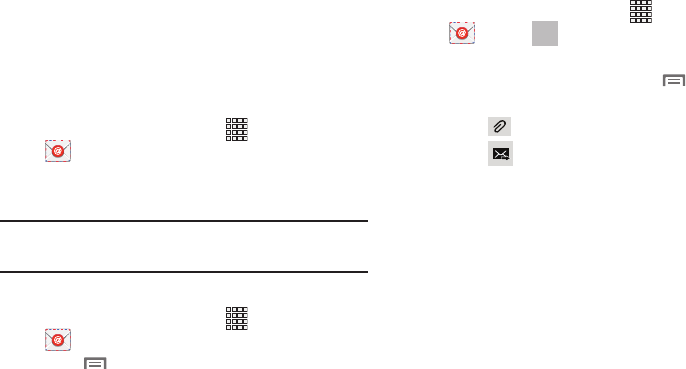
78
Email
Send and receive email using popular email services.
Configuring Email Accounts
You can configure Email for most accounts in just a few
steps.
Configuring the first email account
1. From the Home screen, select
Apps
➔
Email
.
2. Select your email provider, then follow the prompts to
set up your email account.
Note:
For more information on setting up your email, contact
your Wireless Provider.
Configuring additional email accounts
1. From the Home screen, select
Apps
➔
Email
.
2. Touch
Menu
, then touch
Settings
.
3. Select your email provider, then follow the prompts to
set up your email account.
Composing and Sending Email
1. From the Home screen, select
Apps
➔
Email
➔
Compose
.
2. Touch fields to enter recipients and the email text.
3. While composing a message, touch
Menu
for
options.
4. Touch
Attach
to add a file to the message.
5. Touch
Send
to send the message.
DRAFT
FOR INTERNAL USE ONLY

Messaging 79
Managing Emails
Refreshing Your Email Account
Refresh your account to update your phone from the servers.
1. From the Home screen, select
Apps
➔
Email
.
2. Touch
Refresh
.
Email Account Settings
Use Account settings to configure handling of your email.
Note:
Available settings depend on the email provider.
1. From the Home screen, select
Apps
➔
Email
.
2. Touch an account to view it, then touch
Menu
➔
Settings
➔
General preferences
for options.
Gmail
Send and receive emails via Gmail, Google’s web-based
email.
From the Home screen, select
Apps
➔
Gmail
.
Setting Up Your Gmail Account
The first time you launch Gmail, your phone will prompt you
to set up your Google account.
1. From the Home screen, select
Apps
➔
Gmail
.
2. Follow the prompts to sign in, or create a new account.
3. The phone communicates with the Google server to set
up your account and synchronize your email.
Note:
You can use more than one Google account on your
phone. To add another account, from within Gmail, touch
Menu
➔
Settings
➔
ADD ACCOUNT
option.
DRAFT
FOR INTERNAL USE ONLY

80
Refreshing Your Gmail Account
Refresh your account to update messages on your phone.
1. From the Home screen, touch
Apps
➔
Gmail
.
2. Touch
Refresh
.
Managing Your Gmail Account
Use menu options to manage your Gmail.
1. From the Home screen, touch
Apps
➔
Gmail
.
2. Touch
Menu
for options.
Composing and Sending Gmail
1. From the Home screen, touch
Apps
➔
Gmail
➔
New message
.
2. Touch fields and to compose the message. While
composing, touch
Menu
for options.
3. When your message is complete, touch
Send
.
Google Talk
Google Talk is a free Windows and web-based application for
instant messaging offered by Google. Conversation logs are
automatically saved to a Chats area in your Gmail account.
This allows you to search a chat log and store them in your
Gmail accounts.
1. Log on to your Google account if you have not already
done so. For more information, refer to “Your Google™
Account” on page 16.
2. From the Home screen, touch
Apps
➔
Talk
.
3. Begin using Google Talk.
4. Press ➔
Help
for more information on using
Google Talk.
Note:
The Network confirms your login and processes. This
could take up to 5 minutes to complete.
DRAFT
FOR INTERNAL USE ONLY

Messaging 81
Messenger
Messenger allows you to bring groups of friends together into
a simple group conversation. When you get a new
conversation in Messenger, Google+ sends an update to your
phone.
1. Sign on to your Google account. For more information,
refer to “Your Google™ Account” on page 16
2. From the Home screen, touch
Apps
➔
Messenger
.
– or –
From the Google+ application, select
Messenger
.
3. Select the account you want to use to sign in to
Google+.
– or –
Touch
Create a new account
to create another account.
4. At the
Messenger
screen, touch to start a new
message.
5. In the upper text field, enter a name, email address, or
circle.
6. In the bottom message field, enter a message then
touch .
7. From the
Messenger
screen, touch
Learn more
for more
detailed information.
DRAFT
FOR INTERNAL USE ONLY

82
Section 6: Applications and Widgets
This section contains a description of each application and
widget that is available in the Apps and Widget menus, the
function, and how to navigate through that particular
application or widget. If the application or widget is already
described in another section of this user manual, then a
cross reference to that particular section is provided.
This section contains a description of each application
available in the Apps menu and how to launch it. For
applications provided by Samsung, this section also
describes functions and navigation.
If an application is described in another section of this user
manual, a cross reference to that particular section is
provided.
Note:
This manual only addresses applications that have been
loaded on your device as of the date of purchase.
Information concerning third party applications that you
may choose to download from the Google Play Store or
other sources should be obtained from the application
provider directly and not from Samsung.
Tip:
To open applications quickly, add the icons of frequently-
used applications to one of the Home screens. (For
details, see “Customizing the Home Screen” on page 38.)
You can also add an application icon as a Primary
Shortcut that will display on all Home screens. If you add
an application as a primary shortcut, the application icon
will not be displayed in the Apps menu. (For more
information, refer to “Editing the Primary Shortcuts” on
page 39.)
Accessing Applications
1. Press
Home
, then touch
Apps
, and the
Apps
tab. The
Apps
screen appears in the display.
2. Sweep your finger right or left to scroll the Apps
screens.
3. To launch an application, touch the application’s icon.
DRAFT
FOR INTERNAL USE ONLY

Applications and Widgets 83
Customizing the Applications Screens
Choosing a view
By default, application icons appear in Customizable grid
view. You can change the view to Alphabetical grid view or
Alphabetical list view.
1. From the
Apps
screen, touch
Menu
➔
View type
.
The available options are:
• Customizable grid
: Arrange application icons in the order you
prefer.
• Alphabetical grid
: Application icons automatically arranged in
alphabetical order.
• Alphabetical list
: Application icons automatically listed in
alphabetical order.
Moving Application icons
With the
Apps
screen in Customizable grid view, you can
arrange the application icons to suit yourself.
1. From the
Apps
screen, touch
Menu
, then touch
Edit
.
Note:
The
Edit
option is not available with the
Apps
screen
View type
set to
Alphabetical list
.
2. Touch and hold an application icon, then drag it to a
new location.
3. When you are finished, then touch
Save
.
DRAFT
FOR INTERNAL USE ONLY

84
Filtering Application icons
You can select which icons appear in the
Apps
screen.
From the
Apps
screen, touch
Menu
, then touch
either of the following options:
• Downloaded applications
: Shows only those applications you
have downloaded and installed on your phone.
• Hide applications
: Mark those applications you do not want to
appear on the
Apps
screen by touching their icons (check
marks appear in their check boxes), then touch
Done
. The
Apps
screen appears without the hidden applications.
Applications List
AllShare Play
AllShare Play™ wirelessly synchronizes your Samsung
device with your TV, streams content, and even keeps tabs
on who calls or sends text messages with real-time,
on-screen monitoring. Samsung’s AllShare makes staying
connected easy.
Using AllShare Play you can share your in-device media
content with other external DLNA certified™ (Digital Living
Network Alliance) Devices.
Tip:
Wi-Fi capability can be provided to TVs via a digital
multimedia streamer.
AllShare Definitions:
AllShare
This uses the traditional DLNA
technology for sharing multimedia
(photos, videos, or music) to your
Samsung Smart TV and other DLNA
devices.
DRAFT
FOR INTERNAL USE ONLY

Applications and Widgets 85
Important!
Before launching AllShare Play, first connect both
of your communicating devices to the same Wi-Fi
and be using an active/registered Samsung
account. For more information, refer to “Wi-Fi
Settings” on page 140 and to “Creating a Samsung
Account” on page 17.
Important!
The Samsung account manages your access
information (username/password) to several
applications, such as AllShare Play, ChatON, and
Savanna Store.
1. From the
Apps
screen, touch
AllShare Play
.
The AllShare Play screen appears.
2. Touch
Sign in
to sign into your Samsung account, if you
have not already done so. (For more information, refer
to “Creating a Samsung Account” on page 17.)
3. Touch
Start
and follow the on-screen prompts.
AllShare Play
This new feature builds on the
previous AllShare feature. It includes
features such as Web storage
integration and social networking
integration. This is a Web service that
requires using a Samsung account.
AllShare Play/Group
Cast
A subset feature of AllShare Play, this
allows you to mirror photos and
multimedia presentations with other
members of your current Wi-Fi group.
Users must be on the same Wi-Fi and
provide an access code to join the
group.
AllShare Cast
(with
Hub accessory)
This feature functions with an external
Wi-Fi AllShareCast Hub connected to a
TV. It allows you to fully mirror what is
currently displayed on your device to
the external TV.
DRAFT
FOR INTERNAL USE ONLY

86
The application contains two separate streaming media
options:
•Registered storage
: allows you to receive and playback media
stored externally (server, laptop, etc.) directly on your device by
allowing you to add a Web storage service for streaming
content.
• Registered devices
: allows you to stream/share selected
multimedia content from your device to DLNA compliant device
connected to the same Wireless Access Point.
Configuring AllShare Settings
Before using AllShare Play, you must configure it. That is,
set-up parameters such as connected Wi-Fi, Items to share,
source server address, and external device acceptance
rights.
1. From the
Apps
screen, touch
AllShare Play
.
2. Touch
Menu
➔
Settings
. The following options
are available:
•Registered storage
: Lets you add a Web storage location.
Without a storage service/location added, you will not be able
to use AllShare Play.
• My device
: Lets you rename your device.
•Save to
: Lets you save your media to Internal memory (your
phone) or an SD card.
• Auto upload
: Lets you set-up automatic upload of images from
your device to those storage locations specified within the Web
storage list.
•Video optimization
: Lets you optimize the video quality for
streamed video content.
• Password lock
: Lets you restrict access to AllShare Play by
requiring a user enter the currently active and associated
Samsung account password.
• My account
: Lets you view information concerning your
Samsung account.
•Customer support
: Lets you contact the AllShare team via a
new email from an available email account.
• About
: Displays application information.
DRAFT
FOR INTERNAL USE ONLY

Applications and Widgets 87
Sharing Media Using AllShare Play to a Target Device
Important!
Make sure all communicating devices are
connected to the same Wi-Fi.
1. Launch AllShare on the target device (such as an
Internet TV, Samsung Tablet, etc.).
2. From the
Apps
screen, touch
AllShare Play
.
3. From the
Devices
list, touch your device name.
4. Touch an available category tab (
Pictures
,
Music
,
Movies
,
Files
, or
Info
) and select a file.
•
Touch and hold to select multiple files.
•
A file with in the upper-left indicates it is stored remotely
on a web storage location. Selecting this media causes your
device to access the file currently stored on your services’
servers.
5. Touch an available on-screen file, image, or video to
place a green check mark alongside it.
6. Touch
Stream to connected devices
to begin
streaming the selected files.
7. On a target device (ex: Internet TV) select the on-
screen Allow button to continue.
Note:
At this stage your device is requesting access to share
media with the external source.
8. Confirm
AllShare Controller enabled
appears in
the Notification area at the top of the device to indicate
you are using your device as the media source.
AllShare Play Screen Sharing Using Group Cast
Important!
Verify all of your recipients are connected to the
same Wi-Fi.
1. From the
Apps
screen, touch
Gallery
.
2. Touch a picture or video.
3. Touch ➔
Group Play
.
4. If prompted, read the on-screen notification and touch
OK
to continue and return to the main AllShare Play
screen.
5. Enter a security PIN and touch
Done
. This process
makes sure only desired recipients can view your
shared image.
2
DRAFT
FOR INTERNAL USE ONLY

88
6. Re-enter you PIN and touch
Done
. The device then
waits for other connected recipients to accept the
connection and enter the PIN on their screens.
– or –
Touch
Start Group Play anyway
to continue the process
while your users connect.
You can now interact and draw with the on-screen image,
users will instantaneously see the same gestures and also be
able to interact.
Note:
The newly altered image (with markups and comments)
can not be saved, but you can take a screen shot of the
current image and save it to your Clipboard. (For more
information, refer to “Motions” on page 24.)
Calculator
Use your phone’s Calculator to perform arithmetical
calculations (addition, subtraction, multiplication, and
division).
1. From the
Apps
screen, touch
Calculator
.
2. Enter the first number using the on-screen numeric
keys.
3. Enter the operation for your calculation by touching the
corresponding on-screen arithmetic function key.
4. Enter the second number.
5. To view the result, touch equals (
=
).
6. To view calculator history, touch located at
the top of the calculator buttons. A history of your past
calculations is displayed. Touch again to
display the calculator keypad.
7. To clear the calculator history, touch
Menu
➔
Clear history
.
8. To change the text size, touch
Menu
➔
Text size
.
Tap Small, Medium, or Large.
9. Touch
Menu
➔
One-handed operation on
to set
the display so that it is easier to use the calculator with
one hand.
Touch
Menu
➔
One-handed operation off
to turn
it off.
10. To display the scientific calculator, rotate your phone to
the landscape (horizontal) position.
DRAFT
FOR INTERNAL USE ONLY

Applications and Widgets 89
Calendar
Record events and appointments to manage your schedule.
Tip:
A Calendar widget is available in Widgets. (For more
information about placing widgets on the Home screen,
see “Widgets” on page 39.)
1. From the
Apps
screen, touch
Calendar
.
2. Touch a tab to choose a calendar view:
•Year
: Display the current year and scroll to other years.
•Month
: Display the current month and scroll to other months.
• Week
: Display the current week, and scroll to other weeks.
•Day
: Display today’s schedule, and scroll to other days.
•List
: Display events and tasks in a chronological list.
•Task
: Display tasks in a chronological list.
3. Touch
Menu
for these options:
•Go to
: Display a specific date.
•Delete
: Delete an event.
•Search
: Search for calendar events.
•Sync
: Synchronize your phones calendar with your account
calendars. (For more information, refer to
“Setting Up Your
Accounts”
on page 49.)
•Settings
: Customize the calendar.
Customizing the Calendar
1. From the
Apps
screen, touch
Calendar
.
2. Touch
Menu
➔
Settings
to configure these
settings:
•View settings
:
–
View styles
: Choose Month view style (Calendar view + list,
Calendar view +pop-up).
–
Week view
: Choose Timeline or Analog view for a week’s
events.
–
First day of week
: Choose a day to begin each week.
–
Hide declined events
: Enable or disable display of events.
–
Lock time zone
: When enabled, sets event times and dates to
a specified time zone, so that times and dates will not change if
you move to another time zone.
–
Select time zone
: When Lock time zone is enabled, specify the
time zone for all events.
DRAFT
FOR INTERNAL USE ONLY

90
–
Show week number
: Display the number of the week (1 – 52)
in a
W
column to the left of
Sun
.
–
Calendars
: Select calendars to display.
• Event notification
:
–
Set alerts & notifications
: Choose Alert to receive alerts,
Status bar notification to display notifications in the Status bar, or
Off for no notifications or alerts.
–
Select Ringtone
: Choose a ringtone for event notifications,
then touch
OK
.
–
Vibration
: Enable/disable vibration for event notifications.
–
Default reminder time
: Choose a default reminder time for
Calendar events (default time is 15 minutes).
–
Notifications while screen is off
: Enable/disable display of
notifications on the full screen while the screen is blanked.
–
Quick responses
: Pre-composed text to include with email
notifications to meeting attendees, guests, and so on.
•Gesture
:
–
Swipe with two fingers
: Show animation demonstrating how
to change the Calendar view with a simple swipe with two
fingers.
Sending Events
Send events as vCalendar files to other compatible devices.
1. From the
Apps
screen, touch
Calendar
.
2. Touch an event to display its details.
3. Touch
Menu
➔
Share via
.
4. Select the desired Sharing method from the
Share via
pop-up.
5. Follow the prompts to send a copy of a Calendar event
to another device. (For more information, refer to
“Connections” on page 126.)
DRAFT
FOR INTERNAL USE ONLY
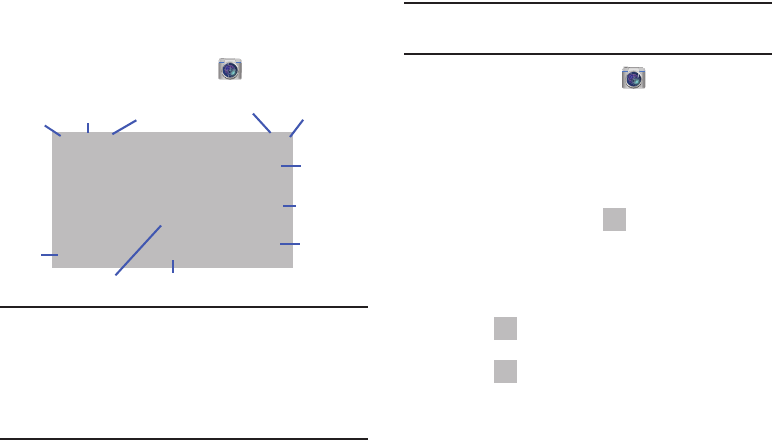
Applications and Widgets 91
Camera
Use your 8.0 megapixel Camera feature to take photos and
save them in JPEG format. Your phone also functions as a
camcorder to record videos and save them in MPEG format.
From the
Apps
screen, touch
Camera
.
Important!
Do not take photos of people without their
permission.
Do not take photos in places where cameras are
not allowed.
Do not take photos in places where you may
interfere with another person’s privacy.
Taking Pictures
Note:
When taking a photo in direct sunlight or in bright
conditions, shadows may appear on the photo.
1. From the
Apps
screen, touch
Camera
.
2. Using the display as a viewfinder, compose your
picture by aiming the lens at the subject.
•
Touch the screen to focus on the area you touched.
•
“Pinch” the screen, or press the
Volume
key, to zoom in or out.
•
To configure settings, see
“Camera Options”
on page 92.
3. To take the picture, touch
Take
.
4. After taking a picture, touch
Image Viewer
to view the
picture. While viewing the picture, use these options:
•
“Pinch” the screen, or touch the zoom icons, to zoom in or out,
or double-touch to zoom all the way in or out.
•
Touch
Camera
to return to the Camera viewfinder
screen.
•
Touch
Share
to send the picture using Group Cast,
Picasa, S Memo, Bluetooth, Wi-Fi Direct, Messaging, Dropbox,
Google+, Email, or Gmail.
Viewfinder
Camera
Image
Viewer
Mode
Effects
Battery
Charge
Change
Mode
Quick Settings
Front
(Gallery)
Video
Record
Take
Picture
Facing
Camera
Displays Front
Facing Camera
DRAFT
FOR INTERNAL USE ONLY

92
•
Touch
Slideshow
to view all of your pictures as a
slideshow.
•
Touch
Delete
to erase the picture (only visible with the
screen in landscape mode).
•
Touch
Menu
to access added options: Face tag, Copy to
clipboard, Rotate left, Rotate right, Crop, Set as (Contact photo,
Home and lock screens, Home/Lock screen wallpaper), Buddy
photo share, Print, Rename, Scan for nearby devices, or
Details.
Camera Options
While in Camera mode, touch the
Options
tab:
•
Self portrait
: Switch to the front camera lens, for self-
portraits.
• Flash
: Choose Off, On, or Auto flash.
• Shooting mode
: Choose an automatic shooting mode,
from:
–
Single shot
: Take a single photo.
–
Best photo
: Takes 8 photos in quick succession, then you
select and save the best.
–
Best face
: Takes 5 photos in quick succession and selects the
best photograph based on open eyes, smiles, sudden
movement, and so on.
–
Face detection
: Touch the Camera button to focus on and take
a picture of the subject’s face.
–
Panorama
: Takes a landscape photo by taking an initial photo
and then adding additional images to itself. The guide box lets
you view the area where the second part of the panoramic
picture should fall within.
–
Share shot
: Uses Wi-Fi Direct to share your pictures quickly
with your friends.
–
HDR
: Takes pictures in HDR (High Dynamic Range) mode to
increase image detail.
–
Buddy photo share
: Uses face recognition from pictures in
your contacts to send your friends or family pictures of
themselves.
–
Beauty
: Adjust the contrast to create a smooth facial feature
effect.
–
Smile shot
: Touch the Camera button to focus on the subject’s
face. If a smile is detected, the picture is taken automatically.
–
Low light
: Take better pictures when the light is low.
DRAFT
FOR INTERNAL USE ONLY

Applications and Widgets 93
• Color effects
: Choose color theme for the picture: No
effect (normal color), Cold vintage, Warm vintage, Posterize,
Solarize, Green point, Blue point, or Red-yellow point, Washed
out, Cartoonify, Black and white, Sepia, or Negative.
• Settings
:
–
Edit shortcuts
: Select which function shortcuts appear in the
function menu.
–
Burst shot
: Detects action to automatically take multiple
pictures to create a panorama.
–
GPS Tag
: Add GPS location information to photo details.
–
Self-portrait
: Set the front camera so you can take pictures of
yourself.
–
Flash
: Choose Off, On, or Auto flash.
–
Shooting mode
: Choose Single shot, Burst shot, Face
detection, Panorama, Share shot, HDR, Buddy photo share,
Beauty, Smile shot, Low light, or Cartoon.
–
Effects
: Apply a color effect to pictures.
–
Scene mode
: Choose a mode to match conditions.
–
Exposure value
: Adjust the picture brightness level by moving
the slider.
–
Focus mode
: Choose a type of automatic focus.
–
Timer
: Set a delay before taking a picture.
–
Resolution
: Choose a size (in pixels) for the image.
–
White balance
: Choose a setting for the light source.
–
ISO
: Choose a setting for imaging sensitivity.
–
Metering
: Select a method for measuring light.
–
Auto contrast
: Allow automatic light/dark adjustment.
–
Guidelines
: Enable or disable an on-screen grid to aid in photo
composition.
–
Auto share shot
: Easily connect to the devices you want to
share pictures with, then bring the devices back together (back-
to-back) to connect them.
–
Anti-Shake
: Enable Anti-Shake to minimize the effect of
camera movement.
–
Contextual filename
(requires GPS tagging): Lets you adjust
the filename based on contextual information, such as your
current GPS location.
–
Image quality
: Choose a quality setting for photos.
–
Storage
: Choose to store your pictures in Phone memory or on
an optional Memory card.
–
Reset
: Set all Camera settings to the defaults.
DRAFT
FOR INTERNAL USE ONLY

94
Camcorder
Use your phone’s built-in Camcorder to record video.
From the
Apps
screen, touch
Camera
➔
Mode
.
Important!
Do not take videos of people without their
permission.
Do not take videos in places where cameras are
not allowed.
Do not take videos in places where you may
interfere with another person’s privacy.
Capturing Video
1. From the
Apps
screen, touch
Camera
➔
Mode
.
2. Using the display as a viewfinder, compose your shot
by aiming the lens at the subject.
•
Touch the screen to focus on the area you touched.
•
“Pinch” the screen, or press the
Volume
key, to zoom in or out.
•
To configure settings, see
“Camcorder Options”
on page 95.
3. To start recording, touch the
Record
button ( ).
4. To capture an image from the video while recording,
touch . This feature is not available when the Anti-
Shake feature is activated.
5. To stop recording, touch the
Stop
button ( ).
6. After recording, touch
Image Viewer
to view the video.
While viewing the video, use these options:
•
Pinch the screen to zoom in or out, or double-touch to zoom all
the way in or out.
•
Touch
Play
to review the video.
•
Touch
Camera
to return to the Camcorder viewfinder
screen.
•
Touch
Share
to send the video.
Mode
Record
Options menu
Image
Viewer
button
button
DRAFT
FOR INTERNAL USE ONLY

Applications and Widgets 95
•
Touch
Slideshow
to review all your videos in sequence.
•
Touch
Delete
to erase the video.
•
Touch
Menu
to rename the video or view details about
the video.
•
Touch
Back
to return to the Camcorder to record more
videos.
Camcorder Options
Configure the camcorder.
While in Camcorder mode, touch the
Options
tab:
• Self recording
: Record video with the front lens.
• Flash
: Choose Off or On.
• Recording mode
: Choose a recording mode, from:
–
Normal
: Record a video of any length.
–
Limit for MMS
: Record a video of a size suitable for sending in
a Video message.
•
Color effects
: Choose color theme for the picture: No
effect (normal color), Cold vintage, Warm vintage, Posterize,
Solarize, Green point, Blue point, Red-yellow point, Washed
out, Cartoonify, Black and white, Sepia, or Negative.
• Settings
.
–
Edit shortcuts
: Select which function shortcuts appear in the
function menu.
–
GPS Tag
: Add GPS location information to video details.
–
Self-recording
: Set the front camera so you can take videos of
yourself or video chat.
–
Flash
: Choose Off or On.
–
Recording mode
: Choose Normal or Limit for MMS recording
mode.
–
Effects
: Apply an effect to videos.
–
Exposure value
: Adjust the picture brightness level by moving
the slider.
–
Timer
: Set a delay before starting recording.
–
Resolution
: Choose a size (in pixels) for the recording.
–
White balance
: Choose a setting for the light source.
–
Guidelines
: Enable to display a grid to aid in video composition.
–
Anti-Shake
: Enable Anti-Shake to minimize the effect of
camcorder movement.
–
Contextual filename
(requires GPS tagging): Lets you adjust
the filename based on contextual information, such as your
current GPS location.
DRAFT
FOR INTERNAL USE ONLY
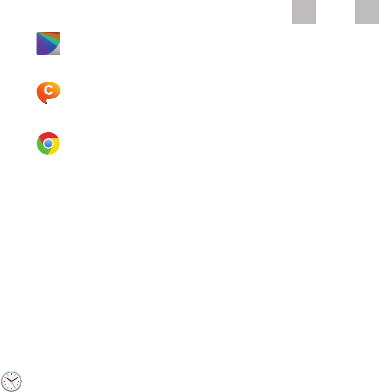
96
–
Video quality
: Choose a quality setting for videos.
–
Storage
: Choose to store your videos in Phone memory or on
an optional Memory card.
–
Reset
: Set all Camcorder settings to the defaults.
Cento Store
From the
Applications
menu, touch
Cento Store
.
ChatON
From the
Applications
menu, touch
ChatON
.
Chrome
From the
Applications
menu, touch
Chrome
.
Clock
The Clock application includes these features:
•
Alarm
: Create alarms to go off once, or to repeat.
•
World clock
: Display the time and date in any time zone.
•
Stopwatch
: Record lap times.
•
Timer
: Measure elapsed time.
•
Desk clock
: Choose whether the clock calendar and weather
appears on the display, and what outputs are active, when you
connect your phone to an optional dock.
From the
Apps
screen, touch
Clock
.
Alarm
This feature lets you set an alarm to ring at a specific time.
1. From the Clock screen, touch
Alarm
➔
Create alarm
.
The following options display:
•Time
: tap
(
Up
) or (
Down
)
to set the new time for the
alarm to sound. Tap AM or PM.
•Alarm repeat
: use this option to set the repeating status for the
alarm by tapping one the days that you want the alarm to
sound. Tap the Repeat weekly checkbox to have the alarm
repeat weekly.
•Alarm type
: sets the way in which the alarm sounds when
activated (Melody, Vibration, Vibration and melody, and
Briefing).
•More
: displays the following additional options:
–
Alarm tone
: sets the sound file which is played when the
alarm is activated. Select an option or tap Add for additional
options.
–
Alarm volume
: drag the slider to adjust the alarm’s volume.
DRAFT
FOR INTERNAL USE ONLY

Applications and Widgets 97
–
Location alarm
: when activated, the alarm only sounds
when you are at a specific location. Touch and slide the
slider to the right to turn it on then follow the on-
screen instructions to enter a location.
–
Snooze
: use this option to set a Duration (3, 5, 10, 15, or 30
Minutes) and Snooze repeat (1, 2, 3, 5, or 10 Times). Tap
the ON/OFF slider to activate.
–
Smart alarm
: tracks body movements and calculates the
best time for sounding the alarm. Place the phone
somewhere on your bed then the phone's movement sensor
(also known as accelerometer) is sensitive enough to work
from any part of the bed. Set the Interval and the Tone. Tap
the ON/OFF slider to activate.
–
Name
: allows you to use a specific name for the alarm. The
name will appear on the display when the alarm activates.
2. Tap
Save
to store the alarm details.
Turning Off an Alarm
To stop an alarm when it sounds, touch and sweep the
icon to the right.
Setting the Snooze Feature
To activate the Snooze feature after an alarm sounds,
touch and sweep the icon to the left. Snooze must
first be set in the Alarm settings. (For more information,
refer to “Alarm” on page 96.)
Deleting Alarms
To delete multiple alarms, follow these steps:
1. From the Clock screen, touch
Alarm
➔
Menu
➔
Delete
.
2. Touch the alarm or alarms you wish to delete. A green
check mark will appear next to each selection.
To delete all alarms, touch
Select all
.
3. Touch
Delete
.
To delete a single alarm:
1. From the Clock screen, touch
Alarm
.
2. Touch and hold on the alarm you want to delete. A pop-
up menu appears.
3. Touch
Delete
.
Z
Z
Z
Z
DRAFT
FOR INTERNAL USE ONLY

98
World Clock
World Clock allows you to view the time of day or night in
other parts of the world. World Clock displays time in
hundreds of different cities, within all 24 time zones around
the world.
1. From the Clock screen, touch
World Clock
. The clock
for your time zone appears.
2. Touch
Add city
to add another city to the World Clock.
3. Scroll through the list of cities to find the city you want
to add, or tap the Search bar and use the keypad to
enter a city to search for.
4. Touch the city you want to add. The clock for that city
will display.
5. To set Daylight Savings time, press and hold a city,
then touch
DST settings
.
6. Select
Automatic
,
Off
, or
1 hour
.
7. If Daylight Savings Time is selected, a sun symbol on
the World Clock listing will appear.
Deleting a World Clock Entry
1. From the Clock screen, touch
World Clock
➔
Menu
➔
Delete
.
2. Touch and hold the city clocks you wish to delete.
3. Touch
Delete
.
Stopwatch
You can use this option to measure intervals of time.
1. From the Clock screen, touch
Stopwatch
.
2. Touch
Start
to start the stopwatch and touch
Lap
to
mark a unit of time per lap.
3. Touch
Stop
to stop the stopwatch.
4. Touch
Restart
to continue or touch
Reset
to erase all
times recorded.
DRAFT
FOR INTERNAL USE ONLY

Applications and Widgets 99
Timer
You can use this option to set a countdown timer. Use a timer
to count down to an event based on a preset time length
(hours, minutes, and seconds).
1. From the Clock screen, touch
Timer
.
2. The
Minutes
field is highlighted and set to 1 minute.
Use the keypad to set the number of minutes you want.
3. Touch the
Hours
field to set hours if desired. As you
touch different fields, they will become highlighted.
4. Touch the
Seconds
field to set seconds.
5. Tap
Start
to begin the timer, and touch
Stop
to pause
the timer.
6. After stopping, touch
Restart
to continue, or touch
Reset
to reset the timer back to the original setting.
Desk clock
You can use the Desk clock when you have a desk dock and
you want your phone to display the time, day, date, location,
and weather conditions when it is docked.
1. From the Clock screen, touch
Desk clock
.
The default Desk clock is displayed.
2. Tap to display the Desk clock in full-screen mode.
3. To make changes, touch
➔
Settings
.
4. The following options are displayed while in full-screen
mode:
•Hide status bar
: when this is checked, the status bar is hidden
from view.
• Wallpaper
: tap to select Desk clock wallpaper from Default,
Gallery, or Same as home screen.
•Calendar
: when this is checked, the calendar is displayed. Tap
to uncheck.
• Weather
: when this is activated, the location, temperature, and
weather condition is displayed. Touch and slide the slider to the
right to turn it on .
•Dock
: allows you to set your Dock settings such as Dock
sound, Audio output mode, Desk home screen display,
Automatic unlock, and Audio output.
Contacts
Contacts lets you access and manage your Contacts list,
Contacts Groups, Favorites list, and Speed dial settings. (see
“Contacts” on page 52.)
From the
Apps
screen, touch
Contacts
.
DRAFT
FOR INTERNAL USE ONLY

100
Downloads
View and manage files and other items you download to your
phone.
1. From the
Apps
screen, touch
Downloads
.
2. Touch an item to open it (if an appropriate application
is installed.)
Note:
Applications you download from Google Play™ Store
are managed with the Play Store app, and do not appear
in
Downloads
.
Dropbox
Dropbox is a “cloud” file storage service. The Dropbox app
lets you create an account with Dropbox or link with your
existing Dropbox account. (For more information, refer to
https://www.dropbox.com/
.)
From the
Apps
screen, touch
Dropbox
.
Email
Send and receive email using popular email services. For
more information, see “Email” on page 78.
From the
Apps
screen, touch
Email
.
Flipboard
The Flipboard application creates a personalized digital
magazine out of information being shared with you. Access
news stories, personal feeds and other related material. Flip
through your Facebook news feed, tweets from your Twitter
account, photos from friends, and much more.
From the
Apps
screen, touch
Flipboard
.
DRAFT
FOR INTERNAL USE ONLY

Applications and Widgets 101
Gallery
The Gallery is where you view photos and videos. For photos,
you can also perform basic editing tasks, view a slideshow,
set photos as wallpaper or contact image, and share as a
picture message.
Note:
You can increase Gallery photo and video storage by
installing a memory card. (For more information, refer to
“Installing a Memory Card” on page 8.)
1. From the
Apps
screen, touch
Gallery
.
All of the Albums that hold your pictures and videos will
be displayed with folder name(s) and number of files.
2. Touch an Album and thumbnails of the contents will be
displayed.
Tip:
If your device indicates that memory is full when you
access Gallery, use the
My files
app to delete some of
the files, and try again. (For more information, refer to
“My Files” on page 116.)
Viewing Pictures
1. From the Gallery screen, select an album, then touch a
picture to view it.
2. While viewing a picture, touch on the screen or touch
Menu
for options.
•
Touch
Camera
to return to the Camera viewfinder
screen.
•
Touch
Share
to send the picture using Group Play,
Dropbox, Flipboard, Picasa, Google+, S Memo, Bluetooth, Wi-
Fi Direct, Messaging, Gmail, or Email.
•
Touch
Slideshow
to view all of your pictures as a
slideshow.
•
Touch
Menu
for the following additional options:
–
Delete
: Erase the picture.
–
Face tag
: When enabled, identifies faces with a yellow box, so
you can touch to add tag information.
–
Copy to clipboard
: Create a copy, to paste into other apps.
–
Rotate left
/
Rotate right
: Change the picture’s orientation.
–
Crop
: Change the picture’s size and/or remove portions of the
picture.
–
Set as
: Assign the picture as a Contact photo, or as wallpaper.
DRAFT
FOR INTERNAL USE ONLY

102
–
Buddy photo share
: Send the picture to the Contacts whose
Contact photos match faces in the picture.
–
Print
: Print the picture via Wi-Fi to a compatible Samsung
printer.
–
Rename
: Change the picture’s filename.
–
Scan for nearby devices
: Scan for in-range devices that can
be connected with and sent the current image.
–
Details
: View information about the picture.
Viewing Videos
1. From the Gallery screen, then select an album. A
matrix or list of available videos appears.
2. To play a video, touch its thumbnail or list entry.
3. The following options are available:
•
Touch
Camera
to take pictures or record videos.
•
Touch
Share
to send the picture using Dropbox, Picasa,
Google+, Bluetooth, Wi-Fi Direct, Messaging, YouTube, Gmail,
or Email.
•
Touch
Slideshow
to view all of your videos in sequence.
•
Touch
Menu
for the following additional options:
–
Delete
: Erase the video.
–
Rename
: Change the video’s filename.
–
Details
: View information about the video.
Sharing Using S Beam
You can also share Gallery photos and videos with
compatible devices using S Beam. (For more information,
refer to “S Beam” on page 134.)
DRAFT
FOR INTERNAL USE ONLY

Applications and Widgets 103
Gmail
Send and receive emails via Gmail, Google’s web-based
email.
For more information, see “Gmail” on page 79.
From the
Apps
screen, touch
Gmail
.
Google
Use Google to search the Web.
Tip:
The Google Search Widget is available by default on the
Home screen. For more information Widgets, see “Adding
Widgets to the Home screen” on page 39.
1. From the
Apps
screen, touch
Google
.
2. Enter search criteria. Search results display
automatically. Touch a search result to display it in a
browser window.
Google Settings
Google Settings lets you quickly and easily change shared
settings to tailor a number of Google apps at the same time
to suit your needs.
From the
Applications
menu, touch
Google Settings
.
Help
Use Help to read or view brief instructions or videos on how
to use the features and settings available with your tablet.
1. From the
Applications
screen, touch
Help
.
The
Help
screen appears.
2. Select a topic from the menu on the left side of the
screen.
3. Read or view the selected topic information in the right
side of the screen.
DRAFT
FOR INTERNAL USE ONLY

104
Internet
Your phone is equipped with a full HTML Browser, which
allows you to access the internet.
From the Home screen, select
Internet
. Your
Wireless Provider’s mobile home page appears in the
Internet screen.
Navigating the web
Selecting items on a page
While browsing web pages, use gestures and menus to
navigate:
•
Touch an item to select it.
•
Touch a hyperlink to follow the link.
•
Touch and hold on a hyperlink for options.
Command Keys
•
Touch
Back
to return to the previous page.
•
To go to the next page,
touch
Forward
.
Touching and dragging
•
Touch and drag your finger on the screen to navigate pages, and
to reposition pages within the screen.
Entering text in a field
•
While browsing, touch a text field to display the virtual QWERTY
keyboard to enter text.
Zoom
Note:
Some web pages do not support the Zoom function.
•
Using two fingers, make a pinch motion on the screen.
–
Pinch in to zoom in on a web page.
–
Pinch out to zoom out on a web page.
•
To return a web page to original size, double tap on it.
Entering a URL
Access a web site quickly by entering the URL.
1. Touch the
URL
field at the top of the Internet screen,
then enter the URL using the virtual QWERTY keyboard.
If the
URL
field is not visible, touch and swipe
downward until the
URL
field appears.
2. As you enter characters, potential matches display.
Continue entering characters, or touch a match to
complete the URL, then touch
Go
to load the page.
DRAFT
FOR INTERNAL USE ONLY

Applications and Widgets 105
Copying text
Copy information from a web page.
1. From the Internet screen, browse to the desired web
site.
2. Touch and hold on the text to enable the text selector,
then use the on-screen tools.
Browser Options
From the Internet screen, touch
Menu
for options:
•New window
: Displays a new window so you can browse
multiple URLs. (For more information, refer to
“Using Browser
Windows”
on page 106.)
• Add bookmark
: Lets you add a URL to your bookmark list
• Add shortcut to home screen
: Lets you add a shortcut to your
Home screen.
• Share page
: Lets you share the page using Gmail or as a
message.
• Find on page
: allows you to search in the current page.
• Desktop view
: allows you to assign the browser to display the
current page in the desktop view (to closely mimic the display
as it would appear on a desktop computer).
• Save for offline reading
: allows you to store the current page
in memory so that it can be read later even if you loose your
Internet connection.
•Brightness
: Lets you manually adjust screen brightness or
select Automatic screen brightness.
• Downloads
: Displays the download history.
•Print
: Lets you print the screen or web page on a Samsung
printer using Wi-Fi.
•Settings
: Lets you tailor the Internet browser to suit yourself.
(For more information, refer to
“Internet browser Settings”
on page 107.)
DRAFT
FOR INTERNAL USE ONLY

106
Using Browser Windows
You can have multiple windows open at one time, and you
can switch between windows.
•
To open a new window, on the Internet screen,
touch
Windows
➔
New window
.
•
To switch to another open window, touch
Windows
. Touch
and swipe to the desired window thumbnail, then touch it to
display the window.
•
To close a window, touch
Windows
. Touch
Close
beside a window to close it.
Going Incognito
The Incognito feature lets you view Internet sites without
leaving records in your browser history or search history, and
without traces (such as cookies) being stored on your device.
Note:
Any downloaded files will be preserved and will stay on your
device after you exit the incognito mode.
To add an Incognito window:
1. From your browser window, touch
Windows
➔
Incognito
.
2. A new Incognito window appears.
Note:
The incognito icon appears in the upper-left of the new
browser window while you are in this mode.
3. Browse to the desired web site(s).
To exit from the incognito window:
1. From your browser window, touch (
Windows
).
2. Scroll across the available windows and locate the
Incognito window.
3. Touch next to the incognito window to delete it.
DRAFT
FOR INTERNAL USE ONLY

Applications and Widgets 107
Using Bookmarks
While browsing, bookmark a site to quickly access it later.
Creating a bookmark
1. From the Internet screen, browse to the desired web
site, then touch
Bookmarks
➔
Add
bookmark
. The
Add bookmark
screen appears.
2. Edit the
Name
and
Address
of the new bookmark as
needed, then select the
Location
where you want it
added.
3. Touch
Save
to save the new bookmark.
Accessing bookmarks and history
Launch a bookmarked page, or reload recent pages.
1. From the Internet screen, touch
Bookmarks
.
2. On the tabs, use these options:
•
Touch an item to load the page.
•
Touch and hold on an item for options.
•
Touch
Menu
for more options.
Deleting Bookmarks
1. From the Bookmarks page, touch and hold the
bookmark you want to delete.
2. Touch
Delete bookmark
.
3. In the
Delete
confirmation pop-up, touch
OK
.
Internet browser Settings
To make adjustments in your browser settings, follow these
steps:
1. From the Internet browser screen, touch
Menu
➔
Settings
. The following options are available:
•General
:
–
Set home page
: Sets the current home page for the Web
browser.
–
Form auto-fill
: Lets you fill in web forms with a single touch.
–
Auto-fill text
: Lets you enter text to be used in the Form auto-
fill feature.
DRAFT
FOR INTERNAL USE ONLY
108
• Privacy and security
:
–
Clear cache
: Deletes all currently cached data. Touch
OK
to
complete the process.
–
Clear history
: Clears the browser navigation history. Touch
OK
to complete the process.
–
Show security warnings
: Notifies you if there is a security
issue with the current web site.
–
Accept cookies
: Allows sites, that require cookies, to save and
read cookies from your device.
–
Clear all cookie data
: Deletes all current browser cookie files.
–
Remember form data
: Allows the device to store data from
any previously filled out forms. Remove the check mark to
disable this function.
–
Clear form data
: Deletes any stored data from previously filled
out forms. Touch OK to complete the process.
–
Enable location
: Allows web sites to request access to your
location.
–
Clear location access
: Clears location access for all web
sites. Touch
OK
to complete the process.
–
Remember passwords
: Stores user names and passwords
for visited sites. Remove the check mark to disable this function.
–
Clear passwords
: Deletes any previously stored user names
or passwords. Touch
OK
to complete the process.
–
Enable notifications
: Allows web site notifications. Select
Always on, On demand, or Off.
–
Clear notifications
: Deletes web site notification access
information.
• Accessibility
:
–
Force zoom
: Lets you override the web site’s request to control
zoom.
–
Text size
: Lets you preview the text size, scale the text size
using a slider bar, and minimize the font size using a slider bar.
–
Inverted rendering
: Lets you preview a web page, select
Inverted rendering (black becomes white and vice versa), and
adjust the Contrast using a slider bar.
• Advanced
:
–
Select search engine
: Lets you set your default search engine
to Google, Yahoo!, or Bing.
–
Open in background
: New pages are launched in a separate
page and displayed behind the current one. Remove the check
mark to disable this function.
DRAFT
FOR INTERNAL USE ONLY
Applications and Widgets 109
–
Enable JavaScript
: Enables Javascript for the current Web
page. Without this feature, some pages may not display
properly. Remove the check mark to disable this function.
–
Allow multiple tabs per app
: Lets you use multiple navigation
tabs per application.
–
Enable plug-ins
: Allows the download of plug-ins such as
Adobe Flash.
–
Default storage
: Lets you set your default storage to Phone or
Memory Card.
–
Website settings
: View advanced settings for individual web
sites.
–
Default zoom
: Adjusts the zoom feature. Set to Far, Medium,
or Close.
–
Open pages in overview
: Shows an overview of newly
opened web pages.
–
Auto-fit pages
: Allows web pages to be resized to fit as much
of the screen as possible.
–
Block pop-ups
: Prevents popup advertisement or windows
from appearing on-screen. Remove the check mark to disable
this function.
–
Text encoding
: Adjusts the current text encoding.
–
Reset to default
: Clears all browser data and resets all settings
to default.
• Bandwidth management
:
–
Preload search results
: Lets the browser preload high
confidence search results in the background to help speed up
searches.
–
Page preloading
: Lets the browser preload web pages in
background. (Options: Never, Only on Wi-Fi, or Always.)
–
Load images
: Allows web page images to be loaded along
with the other text components of a loaded website.
•Labs
:
–
Quick controls
: Lets you open quick controls and hide the app
and URL bars by swiping your thumb from the left or right edge
of the screen.
–
Full screen
: Lets you access Full screen mode and hide the
status bar.
DRAFT
FOR INTERNAL USE ONLY
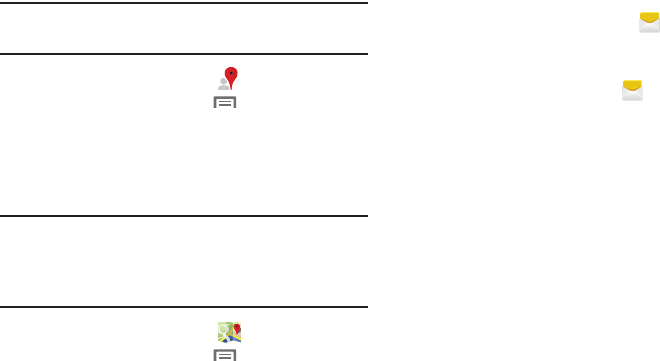
110
Local
Find places of interest near your current location or a
specified locations.
Note:
To use Local, enable location services. (For more
information, refer to “Location services” on page 185.)
1. From the
Apps
screen, touch
Local
.
2. For more information, touch
Menu
➔
Help
.
Maps
Use Google Maps to find your current location, get directions,
and other location-based information. The Google Maps
shortcut appears by default on the Home screen.
Note:
You must enable location services to use Maps, and
some features require Standalone or Google location
services. For more information, see “Location services”
on page 185.
1. From the
Apps
screen, touch
Maps
.
2. For more information, touch
Menu
➔
Help
.
Messaging
Messaging lets you exchange text and multimedia messages
with compatible device users. (For more information, refer to
“Messaging” on page 73.)
From a Home screen, touch the
Messaging
shortcut.
– or –
From the
Apps
screen, touch
Messaging
.
DRAFT
FOR INTERNAL USE ONLY

Applications and Widgets 111
Music
Samsung Music is a subscription based music app that gives
you unlimited access to over 3 million songs from most
major record labels.
You can browse and play the latest releases, genres, artists,
and popular music charts and stream high quality music over
a Wi-Fi and 3G connection.
Note:
Music service requires a Samsung account, and
depends on service availability.
1. From the
Apps
screen, touch
Music
.
2. To rent or buy media, you must have a Samsung
account. Touch
Continue
to log in or create a Samsung
account.
3. Browse content, then follow the prompts to buy or rent.
Music Player
The Music Player is an application that can play music files.
The music player supports files with extensions AAC, AAC+,
eAAC+, MP3, and WMA. Launching the Music Player allows
you to navigate through your music library, play songs, and
create playlists (music files bigger than 300 KB are
displayed).
Playing Music
1. From the
Apps
screen, touch
Music
Player
.
Volume
Shuffle
Repeat
Playback
Controls
Music square
DRAFT
FOR INTERNAL USE ONLY

112
2. Touch a library category tab at the top of the screen
(All, Playlists, Albums, Artists, Music square, or
Folders) to view the available music files.
3. Scroll through the list of songs and touch an entry to
begin playback.
The following Music Player controls are available:
Tip:
When you’re playing music in the background, playback
controls are available on Notifications. For more
information, see “Notifications” on page 33.
Music square
Music square analyzes your music files (a minimum of 25
files) and assigns them to playlists linked to buttons in a 5x5
matrix according to the following criteria:
•
Moods
(Exciting, Passionate, Joyful, Calm)
•
Years
(Exciting, Old, New, and Calm)
Pause the song.
Start the song after being paused.
Press and hold to rewind the song. Touch to go
to previous song.
Press and hold to fast-forward the song. Touch
to go to next song.
Volume control.
Repeat one: Repeats the song currently playing.
Repeat all: Replays the current list when the list
ends.
Play All: Plays the current song list once.
Shuffle On: The current list of songs is randomly
shuffled for playback.
Shuffle Off: Songs are not shuffled but play in
listed order.
Music square: Play songs linked to buttons in a
5x5 matrix and categorized according to four
criteria.
Music list: Returns you to the current playlist.
Now Playing: Displays the Music player screen
with the current song information.
DRAFT
FOR INTERNAL USE ONLY
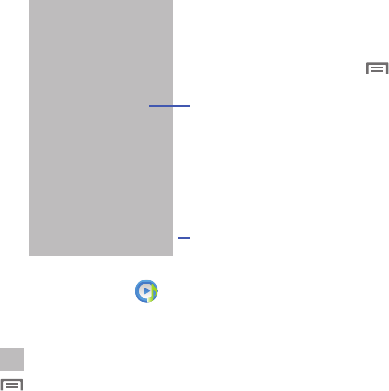
Applications and Widgets 113
1. From the
Apps
screen, touch
Music
Player
.
2. Touch the
Music square
tab.
– or –
Touch
Music square
.
3. Touch ➔
Library update
.
4. Select a playlist based on mood or age of the song.
Music Player Options
To access additional options, follow these steps:
While in the Music Player now playing screen, touch
Menu
. The follow options are available:
• Add to quick list
: Adds the current music file to the Quick list.
• Via Bluetooth
: Scans for devices and pairs with a Bluetooth
headset.
•Share via
: Share your music with other devices using
Bluetooth, Dropbox, Email, Gmail, Group Play, Messaging, or
Wi-Fi Direct.
• Add to playlist:
Add the current music file to a selected playlist.
•Details
: View media information such as Artist, Title,
Biography, and so on.
•Set as:
Set a music file as the Phone ringtone, as a Caller
ringtone, or as the Alarm tone.
• Scan for nearby devices
: Search for nearby Wi-Fi devices for
sharing your music (available when Wi-Fi is turned On). (For
more information, refer to
“Turning Wi-Fi On”
on page 126.)
•Settings
: Change your Music Player settings. For more
information, refer to
“Music Player Settings”
on page 114.
•End
: Close the Music Player app.
Playback
Controls
Playlist
Selection
Buttons
DRAFT
FOR INTERNAL USE ONLY

114
Music Square Options
To access additional options, follow these steps:
From the Music Player Music square screen, touch
Menu
. The follow options are available:
•Help
: Adds the current music file to the Quick list.
• Library update
: Analyzes your music files and assigns them to
playlists linked to playlist selection buttons.
• Change horizontal axis
: Select Mood or Years.
• Scan for nearby devices
: Search for nearby Wi-Fi devices for
sharing your music (available when Wi-Fi is turned On). (For
more information, refer to
“Turning Wi-Fi On”
on page 126.)
• Settings
: Change your Music Player settings. For more
information, refer to
“Music Player Settings”
on page 114.
•End
: Close the Music Player app.
Music Player Settings
The Music Player Settings menu allows you to set
preferences for the music player such as whether you want
the music to play in the background, sound effects, and how
the music menu displays.
While in the Music Player, touch
Menu
➔
Settings
.
The follow settings are available:
•SoundAlive
: Set a type of equalization such as Normal, Pop,
Rock, Jazz, Dance, Classic, etc.
•Play speed
: Set the play speed anywhere between 0.5X and
2.0X using the slider.
• Music menu
: Select which categories you want to display in
the Music menu. Choices are: Albums, Artists, Genres, Music
square, Folders, Composers, Years, Most played, Recently
played, or Recently added.
•Lyrics
: When activated, the lyrics of the song are displayed if
available.
• Music auto off
: When activated, music will automatically turn
off after a set interval.
DRAFT
FOR INTERNAL USE ONLY

Applications and Widgets 115
Using Playlists
Playlists are used to assign songs to a list of preferred media
which can then be grouped into a list for later playback.
These Playlists can be created via either the handset’s Music
Player options menu or from within a 3rd party music
application (such as Windows Media Player) and then
downloaded to the handset.
Creating a Playlist
1. From the
Apps
screen, touch
Music
Player
.
2. Touch the
Playlists
tab.
3. Touch
Menu
➔
Create playlist
.
4. Enter a name for this playlist in the field and touch
OK
.
Adding Music to a Playlist
To add files to the playlist:
1. From the
Apps
screen, touch
Music
Player
.
2. Touch the
Playlists
tab.
3. Touch the playlist name in which to add music.
4. Touch
Add music
.
5. Touch a music file, or touch
Select all
to add all the
music tracks to this playlist then touch
Done
.
Removing Music from a Playlist
To remove music files from a playlist:
1. From the
Apps
screen, touch
Music
Player
.
2. Touch the
Playlists
tab.
3. Touch the playlist name in which to delete music.
4. Touch
Menu
➔
Remove
.
5. Touch the check box to the left of each track you want
to remove from this playlist, or touch
Select all
to
remove all the music tracks from this playlist, then
touch
Remove
.
Editing a Playlist Name
Besides adding and removing music files in a playlist, you
can also rename the playlist.
To edit a playlist:
1. From the
Apps
screen, touch
Music
Player
.
2. Touch
Playlists
.
3. Touch
Menu
➔
Edit title
, then touch the playlist
you want to rename.
4. In the
Edit title
window, enter a new name for the
playlist, then touch
OK
.
DRAFT
FOR INTERNAL USE ONLY

116
For information on downloading music for your phone, see
“Connecting as a Storage Device” on page 130.
Setting a Song as a Ringtone
You can set a song as a ringtone for all voice calls, for calls
from an individual contact, or as an alarm tone.
1. From the
Apps
screen, touch
Music
Player
.
2. Touch and hold on a song, then touch
Set as
and
choose from these options:
• Phone ringtone
: Set the song as the default ringtone for all
incoming voice calls.
• Caller ringtone
: Choose a contact to set the song as the
ringtone for calls from the contact.
•Alarm tone
: Set the song as the alarm ringtone for a new
alarm, or for an existing alarm.
My Files
Find, view and manage files stored on an installed memory
card. If the file is associated with an application on your
phone, you can launch the file in the application.
1. From the
Apps
screen, touch
My Files
.
2. Touch a folder and scroll down or up until you locate a
file.
3. Touch a file to launch it in the associated application (if
the file is associated with an application).
4. While browsing files, use these controls:
•
Touch
Home
to go back to the root directory.
•
Touch
Up
to go back up to a higher directory.
•
Touch
Menu
for options.
DRAFT
FOR INTERNAL USE ONLY
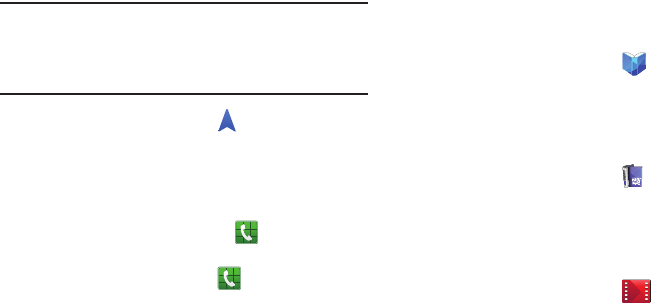
Applications and Widgets 117
Navigation
Use Google Navigation to search for locations, and get turn-
by-turn directions.
Note:
You must enable location services to use Navigation,
and some features require Standalone or Google
location services. For more information, see “Location
services” on page 185.
From the
Apps
screen, touch
Navigation
.
Phone
The Phone application allows you to access the dialer
keypad, call logs, and favorites. For more information, refer
to “Calling” on page 62.
From a Home screen, touch the
Phone
shortcut.
– or –
From the
Apps
screen, touch
Phone
.
Play Books
Google Books is now Google Play™ Books. Discovering your
favorite books and authors has never been easier. With
Google Play Books, you can shop the world's largest
selection of ebooks and read them anywhere you like - on a
tablet, phone, ereader, or the Web.
From the
Apps
screen, touch
Play Books
.
Play Magazines
With Google Play Magazines, you can subscribe to your
favorite magazines and have them available to read on your
phone at any time or any place.
From the
Apps
screen, touch
Play Magazines
.
Play Movies & TV
With Google Play Movies, you can rent thousands of different
movies. You can watch instantly, or download your movie for
offline viewing at a later time.
1. From the
Apps
screen, touch
Play Movies & TV
.
2. Log on to your Google account if you have not already
done so.
3. Following the on-screen instructions for renting and
viewing movies.
DRAFT
FOR INTERNAL USE ONLY

118
Play Music
With Google Play Music, you can play music that you have
added to your music file as well as any music you copied
from your PC. While offline, you can listen to music you have
copied from your PC.
1. From the
Apps
screen, touch
Play Music
.
2. Follow the on-screen instructions to locate and play
music.
Play Store
Android Market is now Google Play™ Store, where all your
favorite books, movies, apps, and games are all in one place
that’s accessible from the Web and your Android device.
You’ll need to have a Google account set up on your phone to
download a new application.
1. From the
Apps
screen, touch
Play Store
.
2. The first time you open Play Store, read the Terms of
Service, then touch
Accept
to continue.
3. Browse for applications to download, then follow the
prompts.
Polaris Office 5.0
From the
Applications
menu, touch
Polaris Office
5.0
.
S Health
From the
Applications
menu, touch
S Health
.
DRAFT
FOR INTERNAL USE ONLY

Applications and Widgets 119
S Memo
The S Memo application allows you to create memos using
the keypad, your finger, or both. You can add images,
handwriting, voice recordings, and typewritten text all in one
place.
1. From the
Apps
screen, touch
S Memo
.
2. Review the
Learn about actions
information pop-up to
learn more about S Memo.
S Voice
S Voice provides plain language voice recognition control of
various features and applications on your phone.
1. From the
Apps
screen, touch
S Voice
.
– or –
From the Home screen, press
Home
twice in
quick succession.
2. Read the Samsung Disclaimer then touch
Confirm
to
continue.
3. Read the Vlingo Terms of Service then touch
Agree
to
continue.
4. Read the information on the
About S Voice
screen, then
touch
Next
.
5. Read the information on the
Say what you want
screen,
then touch
Next
.
6. Read the information on the
Wake up S Voice
screen,
then touch
Next
.
7. Read the information on the
Edit what you said
screen,
then touch
Next
.
8. Read the information on the
Help
screen, then touch
Finish
.
DRAFT
FOR INTERNAL USE ONLY

120
9. At the S Voice screen, say “Hi Galaxy” to wake up
S voice.
10. Speak into the phone and follow the on-screen
instructions.
Samsung Apps
Samsung Apps allows you to easily download many different
types of applications to your phone. You can download
games, news, reference, social networking, navigation, and
other applications.
1. From the
Apps
screen, touch
Samsung Apps
.
2. Read the Disclaimer, Terms and conditions, and Privacy
policy and tap
Accept
to continue.
3. Follow the on-screen instructions to use Samsung
Apps.
Savanna TV
From the
Applications
menu, touch
Savanna TV
.
Settings
Configure your phone to your preferences. For more
information, see “Settings” on page 137.
From the
Apps
screen, touch
Settings
.
Story Album
From the
Apps
screen, touch
Story Album
.
Talk
Use Google Talk to chat with other Google Talk users. For
more information, see “Google Talk” on page 80.
From the
Apps
screen, touch
Talk
.
Translator
From the
Applications
menu, touch
Translator
.
TripAdvisor
From the
Applications
menu, touch
TripAdvisor
.
DRAFT
FOR INTERNAL USE ONLY

Applications and Widgets 121
Video
Video identifies and plays video files (3GP or MP4) stored on
your phone or on an optional microSD Memory card.
1. From the
Apps
screen, touch
Video
.
2. By default, videos display by name in an array of
Thumbnails
.
You can also display your videos in an alphabetical list
by touching the
List
tab, or touch the
Folders
tab to list
the folders where your videos are stored.
3. To play a video, simply touch its thumbnail or list entry.
The following video controls are available:
Note:
The screen view icons are a three-way toggle. The icon
that is displayed, is the mode that will appear after your
touch the icon.
4. While playing a video, touch
Menu
for video
options.
Pause the video.
Start the video after being paused.
Touch and hold to rewind the video.
Touch to go to previous video.
Touch and hold to fast-forward the video.
Touch to go to next video.
Video image capture: Capture the current
video image.
Volume control.
Rotate screen. Toggle screen orientation
between portrait and landscape.
PIP (Picture In Picture) view: The video plays in
a small window so you can use your phone for
other purposes while watching the video.
To return to previous size, double-tap the
screen.
Original size view: The video plays in its
original size.
Full-screen in ratio view: The video is enlarged
as much as possible without becoming
distorted.
Full-screen view. The entire screen is used,
which may cause some image distortion.
DRAFT
FOR INTERNAL USE ONLY

122
Voice Recorder
Record your voice or other sounds, and share recordings via
Bluetooth, Messaging, or Gmail.
From the
Apps
screen, touch
Voice Recorder
.
Voice Search
Voice Search offers voice-activated Google searches. If you
agree, Voice Search uses your location to improve search
results and offer other services.
From the
Apps
screen, touch
Voice Search
.
VPN Client
VPN Client lets you define multiple Virtual Private Networks
(VPNs) to your device and connect to them as needed by
simply selecting a connection from the VPN Client list.
From the
Apps
screen, touch
VPN Client
.
YouTube
Access your YouTube™ account, and view and upload
YouTube videos, right from your phone.
From the
Apps
screen, touch
YouTube
.
DRAFT
FOR INTERNAL USE ONLY

Applications and Widgets 123
Accessing Widgets
1. Press
Home
, then Sweep your finger right or left
to scroll to a particular Home screen panel.
2. Touch
Apps
, then the
Widgets
tab. The
Widgets
screen appears in the display.
– or –
Touch and hold on the displayed
Home screen
panel
until the Home screen menu pops-up, then touch
Add
to Home screen
➔
Apps and widgets
, then the
Widgets
tab. The
Widgets
screen appears in the display.
3. Sweep your finger right or left to scroll through the
Widgets screens and find the desired widget.
4. To place a widget on the selected Home screen panel,
touch and hold the widget’s image or icon, then
position the widget on the Home screen panel.
5. If needed, follow any prompts to configure the widget.
Widgets List
The following widgets are available for executing on your
Home screen:
•
Active Apps Manager 2 x 1:
•
Alarm 4 x 1
: Add, view, and manage alarms you set using this
widget or using the Clock application.
•
Assistive Light 2 x 1
: Use your phone’s flash as a flashlight.
•
Book 1 x 1
: Directly access one of your downloaded electronic
books from
Play Books
.
•
Bookmark 1 x 1:
•
Bookmarks 3 x 2:
•
Burned Calories 4 x 1:
•
Calendar 2 x 2
: View your Calendar events scheduled for today.
•
Calendar (mini today) 4 x 2
: View and access your Calendar
events scheduled for today.
•
Calendar (month) 4 x 4
: View and access your scheduled
Calendar events, one month at a time.
•
Cento Store Widget 4 x 4:
•
Clock (digital) 4 x 1
: View a digital clock-calendar.
•
Clock (digital) 2 x 1
: View a digital clock-calendar.
DRAFT
FOR INTERNAL USE ONLY
124
•
Contact 1 x 1
: Directly access a selected contact for calls or
messaging.
•
Direct Dial 1 x 1
: Immediately call a selected contact.
•
Direct Message 1 x 1
: Immediately send a message to a
selected contact.
•
Directions & Navigation 1 x 1
: Immediately obtain directions to
a selected location.
•
Dropbox Folder 1 x 1
: Directly access one of your Dropbox
folders.
•
Dual clock (digital) 2 x 2
: View digital clock-calendar displays
for two selected locations.
•
Email 4 x 4
: View and directly access email messages in your
Combined email box.
•
Enviroment Comfort 4 x 2:
•
Flipboard 4 x 1
: View a small image of your Flipboard
“magazine”.
•
Gmail 3 x 2
: View and directly access your Gmail messages.
•
Gmail label 1 x 1
: Directly access Gmail messages with a
selected Gmail label.
•
Google Play Books 2 x 2
: Directly access your Google books.
•
Google Play Music 4 x 1
: Directly access and play a selected
music playbook.
•
Google Search 4 x 1
(transparent background): Perform and
manage Internet searches.
•
Google Search 4 x 1
(opaque background): Perform and manage
Internet searches.
•
Messaging 4 x 2
: View and access your latest messages.
•
MobiTiles 2 x 2:
•
Music 4 x 1
: Play your music purchased and downloaded from
Music.
•
Music Player 4 x 1
: Play your music files.
•
Music playlist 1 x 1
: Play a selected music playlist.
•
My Sound 1 x 1:
•
Picture frame 2 x 2
: Directly access your photos and images.
•
Play - My Library 4 x 3
: Access your Google content (ebooks,
music, magazines, and videos).
•
Play Recommendations 4 x 2
: View recommendations from
Google Play Store.
•
Play Store 2 x 2
: View recommendations from and access Google
Play Store.
DRAFT
FOR INTERNAL USE ONLY
Applications and Widgets 125
•
S Bookmarks 2 x 2
: View selected bookmarks and directly
access the related web sites.
•
S Memo 2 x 2
: View and access a stored memo.
•
Savanna Apps 4 x 4:
•
Settings Shortcut 1 x 1
: Directly access selected settings for
your phone.
•
Simple Picture Frame 2 x 2:
•
Slacker Radio 4 x 1
: Access your on-line radio station.
•
Software update 1 x 1
: Directly access your device software
status information and access
Software update
.
•
Story Album Widget 4 x 3:
•
Taken Calories 4 x 1:
•
Traffic 1 x 1
: Directly access traffic information for a selected
destination.
•
Travel Widget 4 x 2:
•
Video Player 2 x 1
: Directly access and play one or more
selected videos.
•
Weather 4 x 2
: View current and forecast temperature and
weather conditions for a selected location.
•
Yahoo! Finance 4 x 2
: View current prices for selected stocks
and/or commodities and directly access additional financial
information.
•
Yahoo! News 4 x 2
: View news headlines and access full news
articles.
•
YouTube 3 x 2
: Receive and view suggested videos. Directly
access your YouTube account.
DRAFT
FOR INTERNAL USE ONLY

126
Section 7: Connections
Wi-Fi
Wi-Fi is a wireless networking technology that provides
access to local area networks.
Wi-Fi communication requires access to an existing Wi-Fi
network. Wi-Fi networks can be Open (unsecured), or
Secured (requiring you to provide login credentials).
Your phone supports the 802.11 a/b/g/n Wi-Fi protocols.
Configuring Wi-Fi Settings
Configure your phone’s Wi-Fi settings. For more information,
see “Wi-Fi Settings” on page 140.
Turning Wi-Fi On or Off
When you turn Wi-Fi service on, your phone automatically
searches for available, in-range “hotspots” [also termed
WAPs (Wireless Access Points)].
Turning Wi-Fi On
1. From the top of the Home screen, sweep your finger
downward to display the Notifications screen.
2. At the top of the Notifications screen, touch
Wi-Fi
to turn Wi-Fi On.
Turning Wi-Fi Off
1. From the top of the Home screen, sweep your finger
downward to display Notifications.
2. At the top of the Notifications screen, touch
Wi-Fi
to turn Wi-Fi Off.
DRAFT
FOR INTERNAL USE ONLY

Connections 127
Scanning and Connecting to a Wi-Fi Network
1. Turn Wi-Fi on (see “Turning Wi-Fi On” on page 126).
Your phone scans for available hotspots and pops-up a
list of any it finds.
2. To connect to a hotspot, touch it on the pop-up list.
•
If the Wi-Fi network is open, you will be automatically
connected.
•
If the Wi-Fi network is secured, enter the password at the
prompt to connect.
Adding a Wi-Fi Network Manually
1. From the Home screen, touch
Menu
➔
Settings
➔
Connections
➔
Wi-Fi
. The
Wi-Fi
options screen appears.
(For more information, refer to “Accessing Settings” on
page 137.)
2. Touch
Wi-Fi
to turn on Wi-Fi.
3. Touch
Add Wi-Fi network
, then enter the following
values:
• Network SSID
: Enter the name of the WAP (Wireless Access
Point).
•Security
: Select the type of security used by the WAP.
•Password
: If the WAP is secured, enter the password or key.
Wi-Fi Direct
Wi-Fi Direct allows devices to connect to each other directly
via Wi-Fi, without a Wi-Fi network or hotspot, and without
having to set up the connection. For example, some printers
support Wi-Fi Direct, and you could print from your phone via
Wi-Fi Direct.
Establishing Wi-Fi Direct Connections
1. From the Home screen, touch
Menu
➔
Settings
➔
Connections
➔
Wi-Fi
➔
Wi-Fi Direct
.
The
Wi-Fi Direct
screen appears, and your phone scans
for available Wi-Fi Direct devices and lists them under
Available devices
.
2. To connect to a single Wi-Fi Direct device, touch its
name in the list.
3. To connect to multiple Wi-Fi Direct devices, touch
Multi-connect
, next touch
Select all
or individual
devices, then touch
Done
.
DRAFT
FOR INTERNAL USE ONLY

128
Bluetooth
Note:
For Hearing Aid Compatibility Information, see page 212.
Bluetooth is a short-range wireless communications
technology for exchanging information over a distance of
about 30 feet.
You don’t need to line up the devices to send information
with Bluetooth. If the devices are in range, you can exchange
information between them, even if they are in different
rooms.
Configuring Bluetooth Settings
Configure your phone’s Bluetooth settings. For more
information, see “Bluetooth settings” on page 142.
Note:
Bluetooth profiles are specifications for services
supported by individual devices. For a list of profiles your
phone supports, see “Bluetooth profiles” on page 141.
Turning Bluetooth On or Off
1. From the Home screen, sweep your finger from the top
of the screen downward to display Notifications.
2. Touch
Bluetooth
to turn Bluetooth On.
Touch
Bluetooth
to turn Bluetooth Off.
Pairing with a Bluetooth Device
Search for a Bluetooth device and pair with it, to exchange
information between your phone and the device.
After pairing, your phone and the target device will connect
with each other and exchange information without a
passcode or PIN.
Note:
When connected, the
Bluetooth connected
icon
displays in the Status Bar. If you receive a new request
for connection while connected with a Bluetooth
headset, a new Bluetooth icon displays at the left of the
Status bar and Notifications displays the connection
request.
1. Activate the target device’s discoverable mode.
DRAFT
FOR INTERNAL USE ONLY

Connections 129
2. On your phone, turn on Bluetooth (see “Turning
Bluetooth On or Off” on page 128). A list of detected
devices pops-up on your display.
3. From the list of detected devices, touch the target
device, your phone attempts to automatically pair with
the target device.
If automatic pairing fails, then follow the prompts to
complete manual pairing:
•
Enter a PIN for the target device and touch OK.
Tip:
Some devices use a default passcode of 0000. Refer to
the target device’s user manual for more information.
•
When prompted to connect with the target device, touch
OK
to
complete the connection, touch
Cancel
to retain the pairing
only.
Connecting with a Bluetooth Device
1. From the Home screen, touch
Menu
➔
Settings
➔
Connections
➔
Bluetooth
. The
Bluetooth
screen appears
in the display.
2. Under
Available devices
, touch a previously paired
device. The device connects with your phone.
VPN
You can use your phone’s VPN (Virtual Private Network)
feature to connect to VPNs.
Configuring VPN Settings
For information about configuring your phone’s VPN settings,
see “VPN” on page 149.
Accessing a VPN
1. From the Home screen, touch
Menu
➔
Settings
➔
Connections
.
2. Under
Wireless and network
, touch
More networks
➔
VPN
. The
VPN
screen appears, listing available VPN
connections.
3. Touch
a VPN and follow any prompts to access the
network.
DRAFT
FOR INTERNAL USE ONLY

130
PC Connections
You can connect your device to a PC using an optional PC
data cable using various USB connection modes.
Storage
: Lets you use the built-in mass storage and memory
card capacity of the phone to store and upload files. This
option lets your computer treat your phone’s installed and
card memory as removable storage drives.
Kies air
: Lets you wirelessly synchronize files on your phone
(in mass storage and on a memory card) with files on your
Windows PC, provided they are both on the same Wi-Fi
network.
Note:
To sync your device to your PC it is highly recommended
that you install Samsung Kies which is available at
http://www.samsung.com/kies
(for Windows/Mac).
Note:
If you are a Windows XP user, ensure that you have
Windows XP Service Pack 3 or higher installed on your
computer. Also, ensure that you have Samsung Kies 2.5
or Windows Media Player 10 or higher installed on your
computer.
Connecting as a Storage Device
You can connect your device to a personal computer, have
your device appear as a removable disk, and access your
device’s file directory. If you insert a memory card in the
device, you can also access the files directory on the
memory card by using the device as a memory card reader.
Note:
The file directory of the memory card displays as a
removable disk, separate from the internal memory.
1. Connect the USB cable to the device and connect the
cable to the computer. After a few seconds, a pop-up
window displays on the PC, prompting you to choose
how to access the new device.
2. On the PC pop-up, click
Open device to view files
.
You can now transfer files between the PC and your
phone’s memory and memory card (if installed).
DRAFT
FOR INTERNAL USE ONLY

Connections 131
Kies via Wi-Fi
Kies via Wi-Fi lets you wirelessly synchronize files on your
phone (in mass storage and on a memory card) with files on
your Windows PC, provided they are both on the same Wi-Fi
network. You can view and share call logs, videos, photos,
music, bookmarks, ringtones, and even send SMS messages
from your PC.
To use Kies air, follow these steps:
1. Sign onto the same Wi-Fi network from your phone and
from your PC.
2. On your phone, from the Home screen, touch ➔
Kies via Wi-Fi
.
3. From the Kies air home screen, touch
Start
.
A web URL is displayed on your phone screen.
4. On your PC, enter the URL in your web browser.
5. On your phone, an Access Request prompt is
displayed. Touch
Allow
to continue.
6. Touch the
Remember for today
check box if you will be
using Kies air with the same PC later.
7. From your PC, a security warning may be displayed
asking if you want to run this application. Click
Run
to
continue.
8. On your PC, the Kies air screen is displayed. On your
phone, the icon appears on the Status Bar.
9. Follow the on-screen instructions to view and share
information between your phone and PC.
10. To exit the Kies air application, touch
Stop
on your
phone, then exit the web browser on your PC.
DRAFT
FOR INTERNAL USE ONLY

132
Tethering
Use Tethering to share your phone’s internet connection with
a computer connected to your device using the USB data/
charging cable, or using Bluetooth.
(For more information, refer to “Tethering” on page 149.)
1. From the Home screen, touch
Menu
➔
Settings
➔
Connections
➔
More networks
➔
Tethering and portable
hotspot
. The
Tethering and portable hotspot
screen
appears.
2. Choose a tethering method:
• USB tethering
: Connect the computer to the phone via USB
cable, then touch
USB Tethering
to turn tethering On or Off.
When On, a check appears in the check box.
• Bluetooth tethering
: Connect your phone with the computer
using Bluetooth. Consult the computer’s documentation for
more information about using your computer to make a
Bluetooth connect. Touch
Bluetooth Tethering
to turn tethering
On or Off. When On, a check appears in the check box.
Note:
Using Tethering requires a subscription to your Wireless
Provider’s mobile data service.
Portable Wi-Fi Hotspot
Use Portable Wi-Fi Hotspot to share your phone’s internet
connection with a PC or other device through Wi-Fi, using
your phone as the mobile hotspot.
Note:
Portable Wi-Fi Hotspot requires a subscription to the
applicable service to use the application.
Portable Wi-Fi Hotspot consumes battery power and
uses data service. While the Portable Wi-Fi Hotspot is
active, your phone’s applications will use the Portable
Wi-Fi Hotspot data feature allowance.
Configuring Portable Wi-Fi Hotspot Settings
Configure your phone’s Portable Wi-Fi Hotspot settings,
including your phone’s name and password, and set the
visibility of your phone’s Wi-Fi hotspot.
Tip:
By default, your device’s mobile hotspot has no security
applied, and any device can connect. (For more
information about configuring your mobile hotspot, see
“Portable Wi-Fi Hotspot” on page 147.)
DRAFT
FOR INTERNAL USE ONLY

Connections 133
Activating Portable Wi-Fi Hotspot
Activate your phone’s Portable Wi-Fi Hotspot application to
allow other devices to use your phone’s internet connection.
1. From the Home screen, touch
Menu
➔
Settings
➔
Connections
. The
Settings
screen appears.
2. Under
Network conenctions
, touch
More networks
➔
Tethering and portable hotspot
➔
Portable Wi-Fi Hotspot
.
3. Touch
Portable Wi-Fi Hotspot
and follow the
prompts to turn Portable Wi-Fi Hotspot On.
Connecting a Device via Portable Wi-Fi Hotspot
Use the other device’s Wi-Fi control to connect to your
phone’s Portable Wi-Fi Hotspot.
1. Activate Portable Wi-Fi Hotspot on your phone. (For
more information, see “Activating Portable Wi-Fi
Hotspot” on page 133.)
2. Activate Wi-Fi on the other device, using that device’s
Wi-Fi control.
3. Scan for Wi-Fi hotspots, and select your phone from
the list. (To find your phone’s name, see “Configuring
Portable Wi-Fi Hotspot” on page 148.)
4. At the prompt, enter your phone’s Portable Wi-Fi
Hotspot password.
By default, the password is your phone’s telephone
number. (For information on changing your phone’s
Portable Wi-Fi Hotspot password, see “Configuring
Portable Wi-Fi Hotspot” on page 148.)
DRAFT
FOR INTERNAL USE ONLY

134
Beaming
NFC
NFC (Near Field Communication) allows data exchange when
you touch your device with another compatible device. This
is used for applications such as Android Beam and S Beam.
1. From the Home screen, touch
Menu
, then touch
Settings
➔
Connections
.
2. Under
Connect and Share
, touch
NFC
to enable
or disable NFC.
Note: NFC
must be turned on to use
Android Beam
or
S Beam
.
S Beam
When S Beam is activated, you can beam files to another
NFC-capable device by holding the devices close together.
You can beam images and videos from your gallery, music
files from your music player, and more.
Turning S Beam On or Off
1. From the Home screen, touch
Menu
, then touch
Settings
➔
Connections
.
2. Under
Connect and Share
, touch
NFC
to enable
NFC. NFC must be enabled to use S Beam. When
enabled, a check mark appears in the check box.
3. Touch
S Beam
to turn S Beam On, or
touch
SBeam
to turn S Beam Off.
DRAFT
FOR INTERNAL USE ONLY

Connections 135
Using S Beam
1. Turn
S Beam
On. (See “Turning S Beam On or Off” .)
2. Launch
Camera
,
Music Player
, or
Gallery
(See “Applications and Widgets” on page 82.) When
using Gallery, you can select multiple files to S Beam.
3. Place your phone back-to-back with the device to
receive your “beamed” content, then touch the screen
on your phone. The receiving device prompts the user
to accept your “beamed” content.
4. Once the user of the receiving device accepts your
“beamed” content, it appears on the screen of that
device.
Nearby devices
Share files with nearby DLNA certified devices over Wi-Fi.
(For information on configuring Nearby devices, For more
information, refer to “Nearby devices” on page 151.)
Note:
To use Nearby devices for sharing, you must have set up
a connection with another Wi-Fi device that supports
DLNA.
1. Connect your phone and another DLNA certified device
to the same Wi-Fi network. (For more information, refer
to “Wi-Fi” on page 126.)
2. On your phone press
Home
, then touch
Menu
➔
Settings
. The
Settings
screen appears.
3. Under
Wireless and network
, touch
More settings
➔
Nearby devices
. The
Nearby devices
screen appears.
4. Touch
File sharing
to turn file sharing via DLNA On or
Off. When On, a check mark appears in the check box.
DRAFT
FOR INTERNAL USE ONLY

136
Screen Mirroring
Screen Mirroring lets your phone share the contents of its
display with other Digital Living Network Alliance (DLNA)
certified devices, such as Smart televisions.
Note:
To view more information about DLNA certified products
visit
http://www.dlna.org/home
.
1. Connect your phone and another DLNA certified device
to the same Wi-Fi network. (For more information, refer
to “Wi-Fi” on page 126.)
2. On your phone press
Home
, then touch
Menu
➔
Settings
. The
Settings
screen appears.
3. Under
Wireless and network
, touch
More settings
. The
Wireless and networks
screen appears.
4. Touch
Screen Mirroring
. The
AllShare Cast
screen
appears with
AllShare Cast
already active and begins
scanning for available devices. All detected DLNA
certified devices are listed under
Available devices
.
5. Touch the desired device to establish a connection. You
can now view the contents of your phone’s display on
the connected device.
Memory Card
Your phone supports removable microSD™ or microSDHC™
memory cards of up to 64GB capacity, for storage of music,
pictures, videos, and other files.
Installing and Removing a Memory Card
(For more information about installing and removing a
memory card, see “Installing a Memory Card” on page 8.)
Important!
To prevent damage to information stored on the
memory card, unmount the card before removing it
from the phone.
Formatting a Memory Card
Use the Erase SD card setting to remove all content from an
installed memory card.
1. From the Home screen, touch
Menu
➔
Settings
.
2. Under
Device
, touch
Storage
.
3. Under
SD card
, touch
Unmount SD card
.
4. After unmounting the SD card, touch
Format SD card
,
then follow the prompts to confirm the deletion of
information from the card.
DRAFT
FOR INTERNAL USE ONLY

Settings 137
Section 8: Settings
Accessing Settings
From the Home screen, touch
Menu
➔
Settings
.
– or –
From the Home screen, touch
Apps
➔
Settings
.
The
Settings
menu appears.
Note:
This section does not include information about Call
settings. (For Call settings information, see “Call
Settings” on page 68.)
Settings Tabs
Your phone’s Settings are divided into 4 main groups. When
the Settings screen appears, the following 4 tabs are located
at the top of the screen:
Connections
: Wi-Fi, Bluetooth, Airplane Mode, Data
usage, More settings, NFC, S Beam, Nearby
devices, AllShare Cast, and Kies via Wi-Fi.
My device
: Home screen mode, Call, Blocking
mode, Sound, Display, Power saving mode, Lock
screen, Safety assurance, Accessory, Date and
time, Accessibility, Language and input, Motions,
and Air view.
Accounts
: Samsung account, Add account, Backup
and reset.
More
: Location access, Security, Application
manager, Battery, Storage, and About device.
DRAFT
FOR INTERNAL USE ONLY

138
Using Setting Sliders
To enable or disable a setting, touch the setting slider
as shown.
Accessing Additional Options
To access additional setting options, touch the setting
label.
DRAFT
FOR INTERNAL USE ONLY
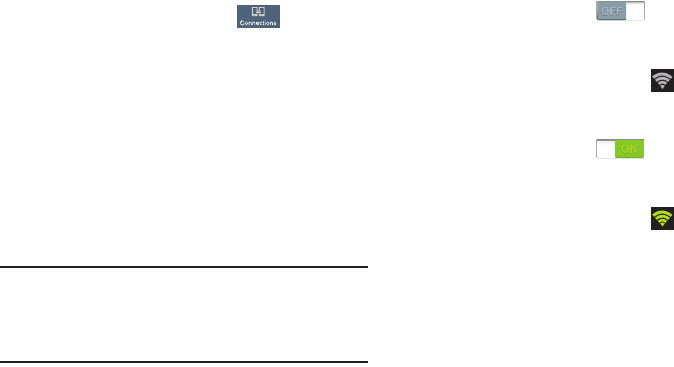
Settings 139
Connections
To access your phone’s Connections settings:
From the
Settings
screen, touch
Connections
.
The
Connections
screen appears.
Wi-Fi
Set up and manage your phone’s connections to Wi-Fi
networks. Your phone supports Wi-Fi a/b/g/n.
(For more information about using Wi-Fi, see “Wi-Fi” on
page 126.)
Turning Wi-Fi On or Off
Turn your phone’s Wi-Fi service on or off. When you turn Wi-
Fi service on, your phone automatically searches for nearby
available Wi-Fi networks.
Tip:
When you turn Wi-Fi service on, your phone automatically
searches for available networks and displays them.
You can also turn Wi-Fi On or Off from the Notifications
panel.
Turn Wi-Fi On:
From the
Connections
screen, under
Network
connections
, touch
Wi-Fi
.
– or –
From the Home screen and others, touch and swipe the
Status Bar downward, then touch
Wi-Fi
.
Turn Wi-Fi Off:
From the
Connections
screen, under
Network
connections
, touch
Wi-Fi
.
– or –
From the Home screen and others, touch and swipe the
Status Bar downward, then touch
Wi-Fi
.
DRAFT
FOR INTERNAL USE ONLY

140
Wi-Fi Settings
Configure and manage connections to Wi-Fi access points.
1. From the
Connections
screen, under
Network
connections
, touch
Wi-Fi
. The
Wi-Fi
options screen
appears.
2. Touch options to configure:
•Add Wi-Fi network
: Connect to a new Wi-Fi network (see
“Adding a Wi-Fi Network Manually”
on page 127).
•Scan
: Search for available Wi-Fi networks.
• Wi-Fi Direct
: Access Wi-Fi Direct settings (see
“Wi-Fi Direct”
on page 141.)
3. Touch
Menu
to access the following additional
options:
• Advanced
: View and configure your phone’s Advanced Wi-Fi
settings.
• WPS push button
: Record/send the signal from the Wi-Fi
Protected Set-up push button on your Wi-Fi router.
• WPS PIN entry
: Record/send the Wi-Fi Protected Set-up
Personal Identification Number for your Wi-Fi router.
•Help
: Provides on-line assistance to perform Wi-Fi interface
tasks.
Advanced Wi-Fi settings
1. From the
Connections
screen, under
Network
connections
, touch
Wi-Fi
➔
Menu
➔
Advanced
.
2. Configure settings:
• Network notification
: When enabled, your phone notifies you
of nearby Wi-Fi networks when you launch a high data-usage
application.
• Passpoint
: When set to ON, your phone automatically
connects to passpoint-enabled hotspots.
• Keep Wi-Fi on during sleep
: Specify when to switch from
Wi-Fi to mobile data for data communications, when the phone
goes to sleep (when the backlight goes out). This setting can
affect your data usage, and the behavior of devices you
connect to your phone, such as when tethering or using Mobile
Hotspot.
• Check for Internet service
: Check whether Wi-Fi Internet
service is available when connected to a W-Fi hotspot.
•MAC address
: (Not configurable) View your phone’s MAC
address, needed for connecting to some secured networks
(only shows when Wi-Fi is active).
•IP address
:
(Not configurable) View your phone’s IP address
(only shows when connected to a Wi-Fi network).
DRAFT
FOR INTERNAL USE ONLY
Settings 141
Wi-Fi Direct
Wi-Fi Direct allows devices to connect to each other directly
via Wi-Fi, without a Wi-Fi network or hotspot, and without
having to set up the connection. For example, some printers
support Wi-Fi Direct, and you could print from your phone via
Wi-Fi Direct.
Turning Wi-Fi Direct On or Off
From the
Connections
screen, under
Network
connections
, touch
Wi-Fi
➔
Wi-Fi Direct
.
The
Wi-Fi Direct
screen appears, and your phone scans
for available Wi-Fi Direct devices and lists them under
Available devices
.
(For information on connecting your phone to other
Wi-Fi Direct devices, see “Establishing Wi-Fi Direct
Connections” on page 127.)
Bluetooth
Your phone supports Bluetooth® 4.0.
Bluetooth profiles
Bluetooth profiles are specifications for services supported
by individual devices. Profiles improve the ability of different
devices to work together. Your phone supports these
Bluetooth profiles:
•
Headset
: HSP v1.2 profile supports use of compatible Bluetooth
headsets for mono voice.
•
Handsfree
: HFP v1.5 profile supports Bluetooth headsets, and
may also support other compatible Bluetooth devices with
speakerphone capabilities.
•
Stereo
: A2DP v1.2, AVRCP v1.0, GAVDP 1.2, AVCTP 1.3 and
AVDTP 1.2 profiles support delivery of stereo audio to compatible
Bluetooth devices.
•
Object Exchange
: OPP v1.0 profile allows sending and receiving
of contact name cards (vCard 2.1) and calendar events
(vCalendar) between devices. PBAP v1.2 supports exchange of
Phone Book Objects.
•
Human Interface Devices
: HID v1.0 profile supports certain
interface devices.
DRAFT
FOR INTERNAL USE ONLY

142
•
Personal Area Networking
: PAN 1.0 supports exchange of data
with other devices.
•
Message Access Profile
: MAP 1.0 allows exchange of messages
between devices, such as with an automotive hands-free device.
Turning Bluetooth On or Off
Turn Bluetooth On:
From the
Connections
screen, under
Network
connections
, touch
Bluetooth
.
Turn Bluetooth Off:
From the
Connections
screen, under
Network
connections
, touch
Bluetooth
.
Tip:
You can also turn Bluetooth On or Off at the Notifications
Panel.
Bluetooth settings
Pair and connect with other Bluetooth devices, manage your
Bluetooth connections, and control your device’s visibility to
other devices.
Note:
Bluetooth must be turned On to access Bluetooth
settings.
1. From the
Connections
screen, under
Network
connections
, touch
Bluetooth
.
2. Touch a setting to configure Bluetooth:
•
Touch
Bluetooth
to turn Bluetooth On,
or touch
Bluetooth
to turn Bluetooth Off.
•
Under
My device
, touch your phone’s name to enable/disable
its visibility to other devices’ Bluetooth searches. Available
when Bluetooth is ON.
•
Touch
Scan
to search for visible Bluetooth devices. Touch a
detected device to pair with it (see
“Pairing with a Bluetooth
Device”
on page 128).
DRAFT
FOR INTERNAL USE ONLY

Settings 143
•
Touch
Menu
to access the following options:
–
Visibility time-out
: Select how long your phone will remain
visible to other devices.
–
Received files
: Lists files received from other devices over
Bluetooth connections.
–
Help
: Provides on-line instructions for using your phone’s
Bluetooth interface.
Data usage
Control your device’s connection to your Wireless Provider’s
data service, and monitor your data usage.
Setting a mobile data limit
Setting a mobile data limit causes your phone to
automatically disable the Mobile data connection when the
limit is reached. You can set a warning threshold, to have
your device alert you when data usage nears your set limit.
Data usage is measure by your device, and your service
provider may account for usage differently, so you may want
to consider using a conservative limit. Contact your service
provider for more information on actual data usage.
DRAFT
FOR INTERNAL USE ONLY
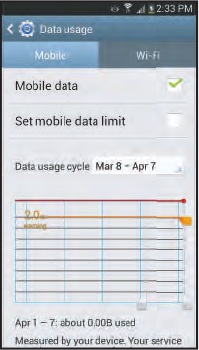
144
1. From the
Connections
screen, under
Network
connections
, touch
Data usage
. The
Data usage
screen
appears.
2. To enable mobile data, touch
Mobile data
.
3. To enable the limit, touch
Set mobile data limit
. A red
limit line appears in the
Data usage
screen.
4. To adjust the mobile
Data usage cycle
, touch and drag
the vertical usage cycle lines left or right on the graph.
5. To adjust the mobile data usage warning level, touch
and drag the horizontal
warning
line up or down on the
graph.
6. To adjust the mobile data usage limit level, touch and
drag the horizontal
limit
line up or down on the graph.
DRAFT
FOR INTERNAL USE ONLY